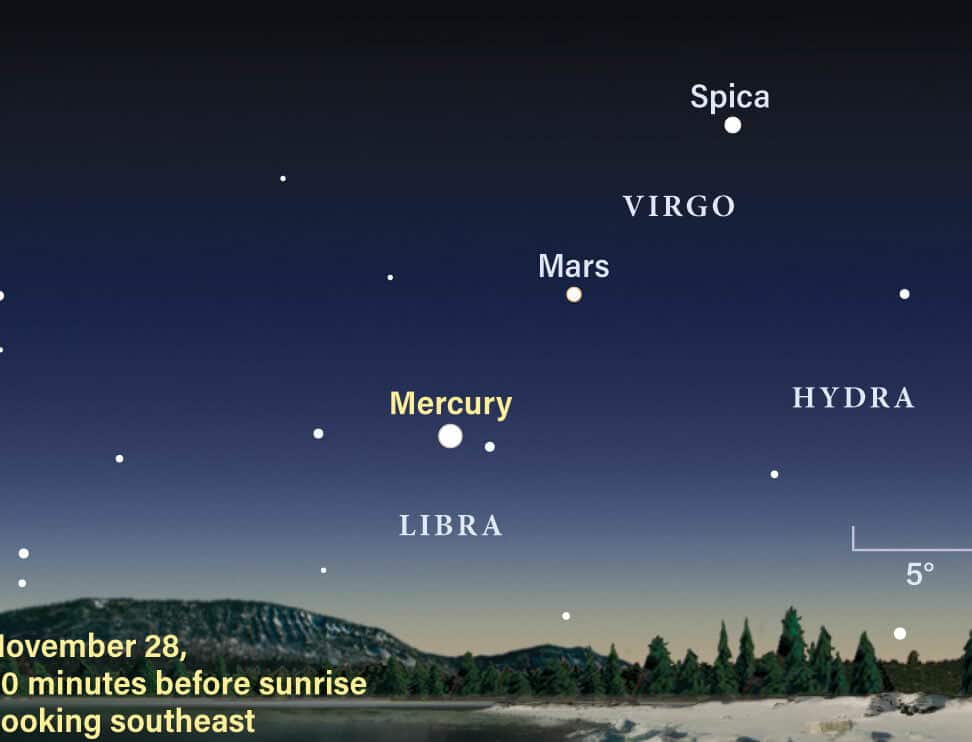The latter part of autumn is arguably the optimal time to explore the celestial expanse. The weather is not excessively cold yet, with frost not yet widespread. Conversely, the nights in November are impressively lengthy, affording ample opportunity to familiarize oneself with almost every accessible constellation at this latitude. However, one drawback presents itself: November offers a limited number of clear nights. Let us examine the appearance of the night sky in November 2019 during the evening, overnight, and in the early morning hours.
November’s Evening Sky Filled with Stars
Let’s embark on a journey through the starry sky on a crisp November evening. The remnants of a stunning sunset still linger in the western horizon, casting a warm glow. As darkness sets in, the brightest stars begin to make their appearance. Of particular interest is a star that hangs low above the western horizon, just above the evening twilight. This star, known as Arcturus, is renowned for its dazzling brilliance and holds the title of being the brightest star in the northern celestial hemisphere. Arcturus also serves as the leading star in the constellation of Volopassus, which resembles a kite or a half-open parachute with Arcturus gracefully gliding through the night sky.
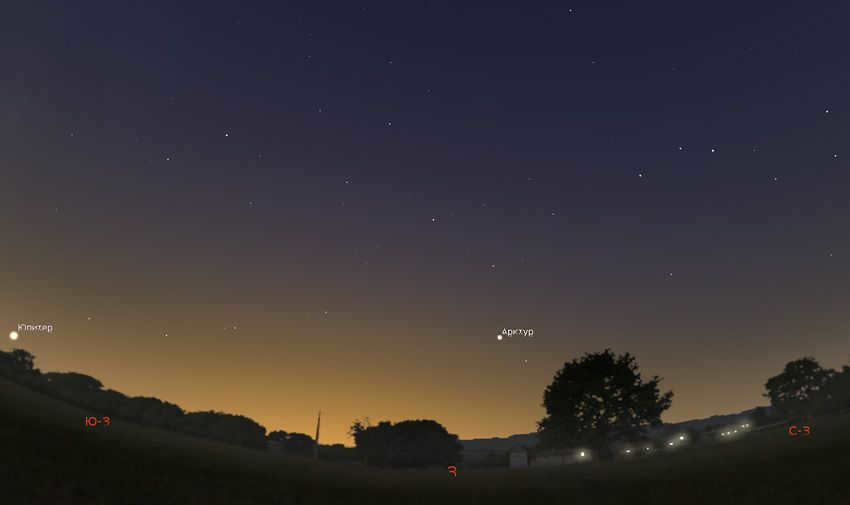
During the month of November, the star Arcturus can be seen in the evening sky. It appears low above the western horizon, contrasting against the backdrop of the setting sun. This information was provided by Stellarium, a popular astronomy software.
Arcturus is commonly associated with the spring season, as it reaches its highest point in the southern sky during May evenings. However, in regions with moderate climates, this star can be observed throughout the year. In spring and summer, Arcturus remains visible all night long. During autumn, it can be seen in the early evening and morning hours, while in winter it is most prominent during the mornings. In the current month of November, Arcturus can be observed for approximately two hours after sunset. It then sets over the northwest horizon and later rises in the northeast, continuing to shine until the break of dawn.
The Amazing Summer Triangle
If you gaze towards the southern sky on an early evening in November, you will be captivated by a magnificent triangle formed by a group of luminous stars. This celestial formation is known as the Great Summer Triangle, also referred to as the summer-fall triangle. It consists of three prominent stars: Vega, which occupies the upper right corner and is the second brightest star in the northern hemisphere after Arcturus, Deneb, located in the upper left corner, and Altair, which marks the lower apex of the triangle. All three of these celestial bodies rank among the twenty brightest stars in the sky and belong to separate constellations. Vega serves as the alpha star of Lyra, Deneb holds the alpha position in the constellation of the Swan, and Altair is the alpha star of the Eagle. As a result, the Summer Triangle does not qualify as a stand-alone constellation. Astronomers refer to such distinctive formations, where stars from various constellations merge or are part of a larger constellation, as asterisms.
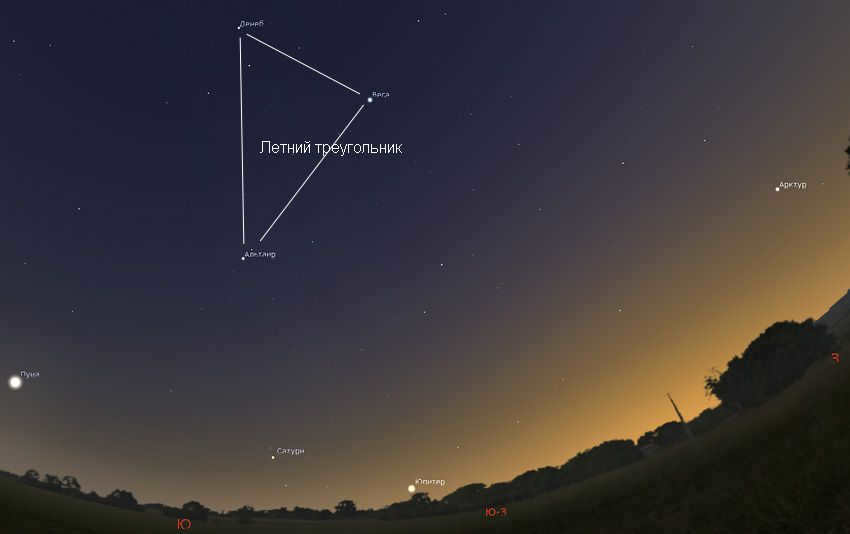
The Grand Summer Triangle and the planets Jupiter and Saturn can be seen in the sky during the month of November in 2019. The Summer Triangle is a notable feature that is visible from June to November, and it serves as a helpful guide for navigating the celestial sphere. By locating the Summer Triangle, one can easily locate other prominent constellations such as Hercules, Serpentor, Sagittarius, Shield, Arrow, and Dolphin.
During the early evenings of November 2019, two additional stars can be observed in the southern sky (as depicted in the image above). These stars are situated below the Summer Triangle and are positioned quite low above the horizon. One of these stars shares a similar brightness to the stars in the triangle, while the other, which is closer to the evening dawn, shines much more brightly!
These celestial bodies are the magnificent Saturn and Jupiter. In the year 2019, both of these planets can be found near the southernmost region of the ecliptic, which is the same area where the Sun will be positioned in December and early January. This explains why both Saturn and Jupiter are situated at a low point in the sky when viewed from our perspective. (However, the opposite is true for those in the southern hemisphere of the Earth!)
Observations of Jupiter can only be made until the end of November 2019, making it the final month to catch a glimpse of this planet. On the other hand, the visibility of Saturn will extend until the end of the year. Following this period, both planets will enter into conjunction with the Sun and gradually shift to the morning sky, where they will be visible towards the end of the winter season.
Hence, in the evening of November, the southern section of the sky is adorned with the mesmerizing summer constellations. But where can we find the constellations of fall?
Pegasus and Andromeda are the constellations that dominate the fall sky.
Located in the southeast and east, these two constellations capture the attention of stargazers during this time of year.
Of all the fall constellations, Pegasus and Andromeda stand out with their unique formation – a large square with a curved handle that stretches from the upper left corner of the square towards the east. The stars of Pegasus form the majority of the square, earning it the name “The Great Square of Pegasus.” The handle of this figure is composed of stars from the Andromeda constellation. The stars within this formation shine with a brilliance comparable to those in the Big Dipper’s bucket.
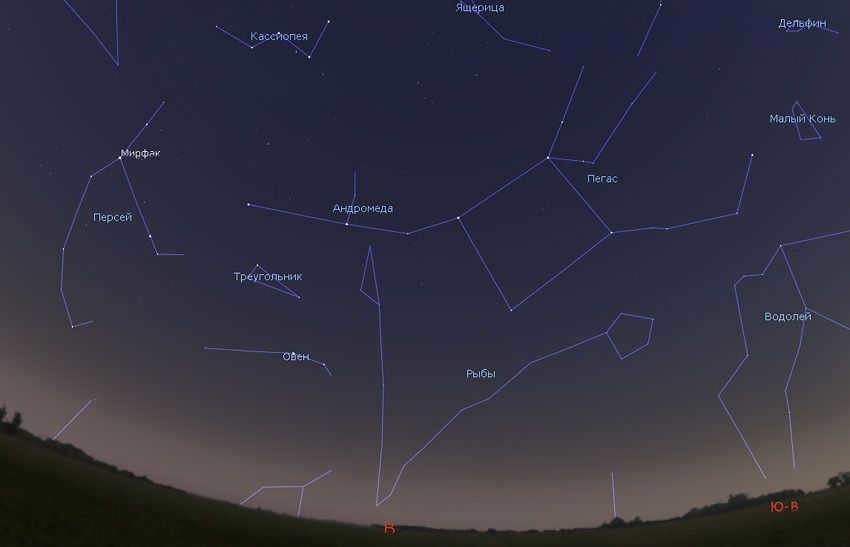
In the evening sky of November, you can observe the constellations Pegasus and Andromeda. This information is provided by Stellarium.
Just below the Square of Pegasus, you will find a vast expanse of space with very few stars. This area is occupied by the constellation of Pisces. If you look below the knob of Andromeda, you will see two small constellations: Triangle and Aries. The Triangle constellation is easily recognizable, while Aries has three stars that form a short broken line, making it stand out.
Observing the northeast direction
When you direct your attention further towards the northeast, an enchanting bright star can be spotted twinkling just above the horizon. This particular celestial body is known as Capella, which holds the prominent position in the constellation called Ascendant. Positioned between Capella and the constellation Andromeda lies the constellation of Perseus, which takes the form of an inverted slingshot or the Greek letter λ. At the peak of Perseus, one can find Cassiopeia, a small yet exquisitely beautiful constellation.
In form, Cassiopeia bears a resemblance to the letter W. This constellation is visible throughout Russia, making it one of the near-polar constellations (there are a total of seven such constellations). Both fall and winter constellations include Perseus. However, Ascendant is unmistakably a winter constellation. During January evenings, the star Capella will shine nearly directly overhead, towering above the brilliant stars of Orion.
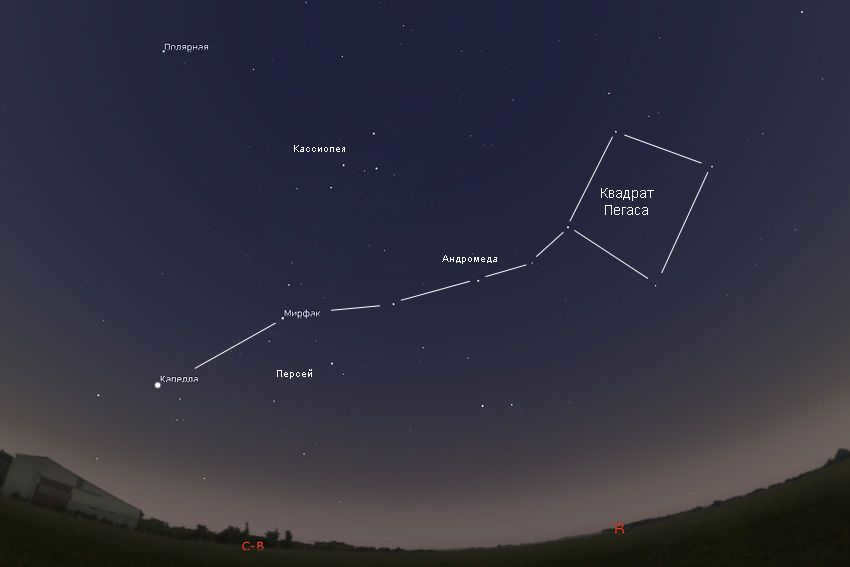
A sequence of stars in the constellation Andromeda leads to the star Mirfak in the constellation Perseus and further to the bright star Capella in the constellation Ascendant. Illustration: Stellarium
The main star of Perseus, Mirfak, is situated between Capella and the outermost star of Andromeda’s “knob”, Alamac. Consequently, in the night sky, there is a very long string of stars connecting the constellations of Pegasus and Ascendant, extending from the south to the north-east.
What is visible on a November evening when looking towards the north? The Big Dipper, of course. This star formation is nearly parallel to the horizon and not particularly high in the sky, just as it is typically depicted in textbooks and various popular publications.
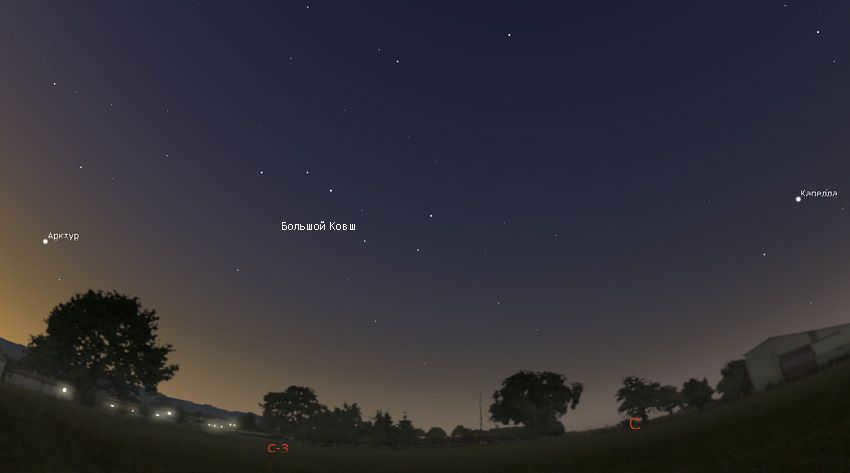
Starry sky in November 2019 during the night
By the time it reaches midnight, the appearance of the starry sky in November undergoes significant changes. This is to be expected, as over the course of six hours since twilight began, the Earth has completed a quarter revolution on its axis. Consequently, the starry sky above us has also “rotated” by a quarter!
As a result, all of the spring constellations, led by the star Arcturus, have already vanished over the western horizon. The same fate has befallen almost all of the summer constellations. Only two stars from the summer triangle, Vega and Deneb, remain. They shimmer in the northwest, just above the horizon.
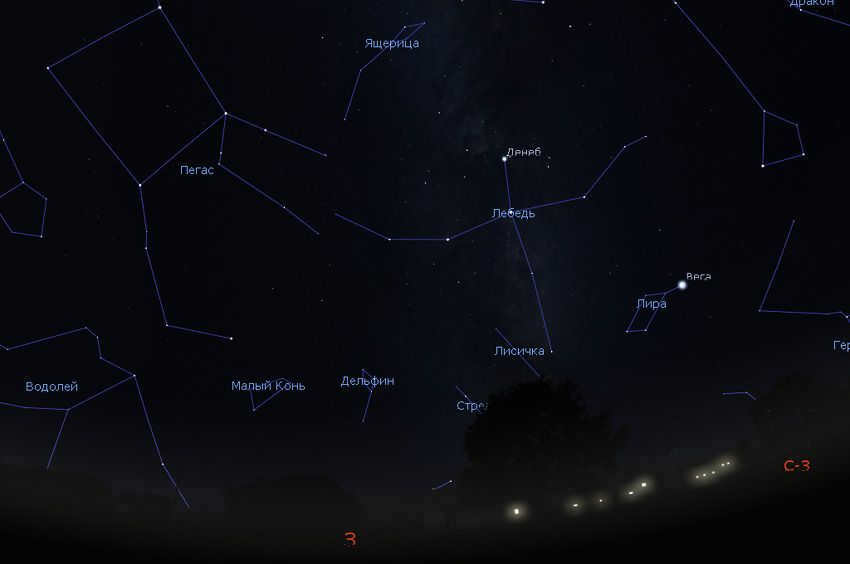
In November, when the clock strikes midnight and you look towards the west, you will be greeted by a breathtaking sight – the starry sky. The square of Pegasus, a prominent constellation, has already reached its highest point in the sky and is now slowly descending towards the horizon in the southwest. Just below the square, you will find the constellation Aquarius, which is also setting over the horizon. Its brightest stars form a beautiful broken chain of stars in the celestial expanse.
Interestingly, right below the constellation Aquarius, you will find the brightest star in the autumn sky – Fomalgaut. This star shines with a brightness comparable to that of Deneb, one of the stars in the famous Summer Triangle. If you are located in southern Russia, you can catch a glimpse of Fomalgaut between 7 and 10 pm. Even in Moscow, this star can be observed, although it will be very low above the horizon. However, if you are further north, like in St. Petersburg, Fomalgaut will no longer be visible.
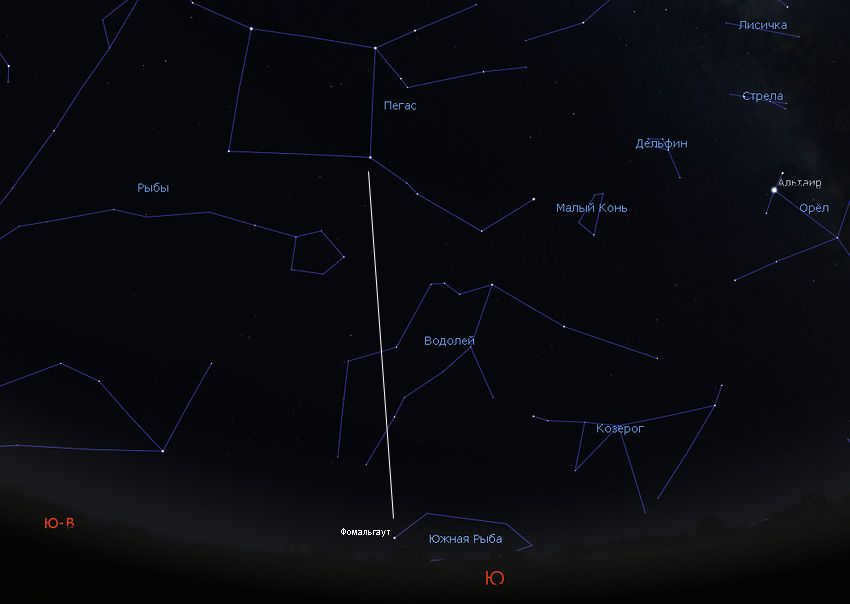
Here’s a little tip on how to locate the star Fomalgaut in the night sky. If you look at the Square of Pegasus, you will notice a pattern of four stars that stretch from the upper left corner towards the east. This pattern belongs to the constellation Andromeda, which can be seen in the southern part of the sky, high above the horizon. On clear nights without the interference of the moon, you might even be able to spot a faint misty spot just above the third star in this chain. That spot is the famous Andromeda Nebula, which happens to be the closest large galaxy to our own and the farthest object in the universe that can be seen with the naked eye.
The arrangement of Keith in the atmosphere during the month of November
The groupings of Triangle, Aries, and Pisces are positioned directly beneath Andromeda, which is also situated at a considerable height in the atmosphere. Below these constellations, the expansive configuration of Keith extends all the way to the horizon. According to mythologies, the ancient Greeks believed Keith to be a massive sea creature dispatched by Poseidon to consume Andromeda, who had been fastened to a rock.
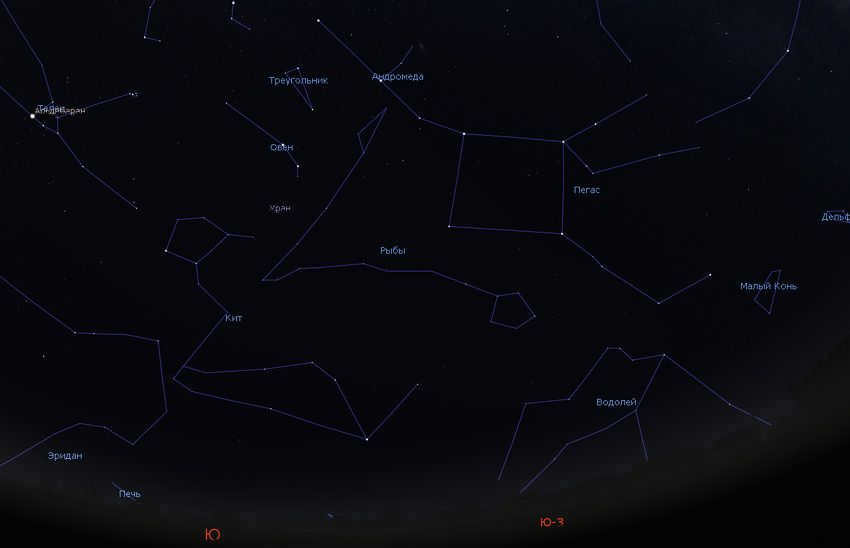
In the starry sky of November, you can observe the constellations of autumn. The image above shows the constellations as seen through Stellarium.
The constellation Keith does not contain any stars that are brighter than 2.5 m. However, it is known for hosting the famous long-period variable star, Mira Kita, which was discovered by David Fabricius in 1596, before the invention of the telescope! Another star in the constellation Keith is Tau Kita, which is one of the closest sun-like stars to our own. It was the subject of a song by Vladimir Vysotsky.
Winter constellations visible in the November sky
The constellations visible during the winter months are quite remarkable and captivating. Orion, Ascendant, Gemini, and Taurus are particularly notable and easily recognizable. These constellations serve as the focal point for the winter sky. Surrounding them are the constellations of Eridanus, Hare, Big Dog, Unicorn, and Little Dog. Each of these winter constellations features at least one exceptionally luminous star, with a magnitude greater than 2.0. However, the constellation of Orion surpasses them all with an impressive count of five such stars!
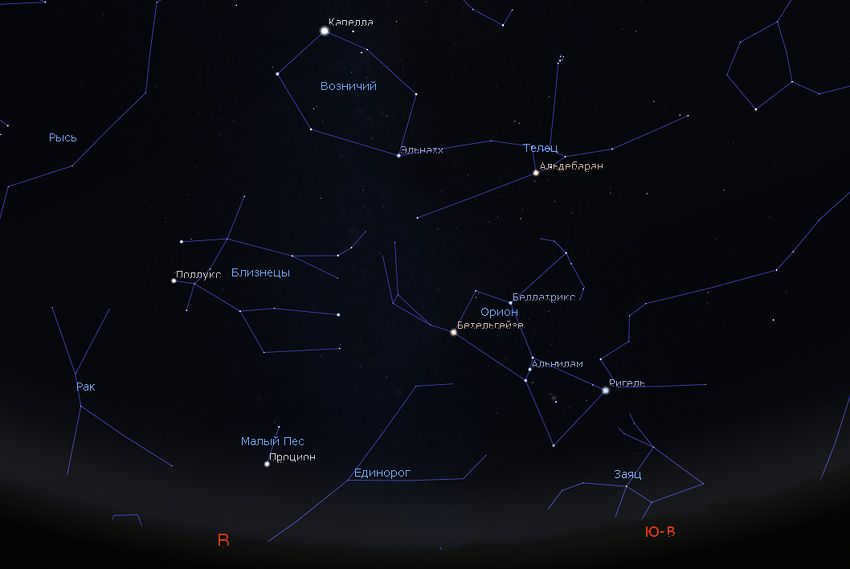
In November, the constellations visible in the winter sky are located in the southeast around midnight. The most prominent of these constellations is Orion, which is easily recognizable due to its remarkably symmetrical seven-star pattern. The three stars that make up Orion’s Belt are at the center of this constellation. By extending a line downward from the Belt, you can find the brightest star in the night sky, Sirius. Alternatively, by extending a line upward from the Belt, you can locate the constellation of Taurus and the Pleiades cluster.
The constellation Gemini is positioned in the eastern sky at midnight, with its two most prominent stars, Castor and Pollux, appearing one above the other. Slightly lower down, between them and Sirius, lies the star Procyon, which serves as the leader of the Lesser Dog constellation.
Almost all of the winter constellations are enclosed by six bright stars that create a massive formation known as the Winter Circle or the winter hexagon.
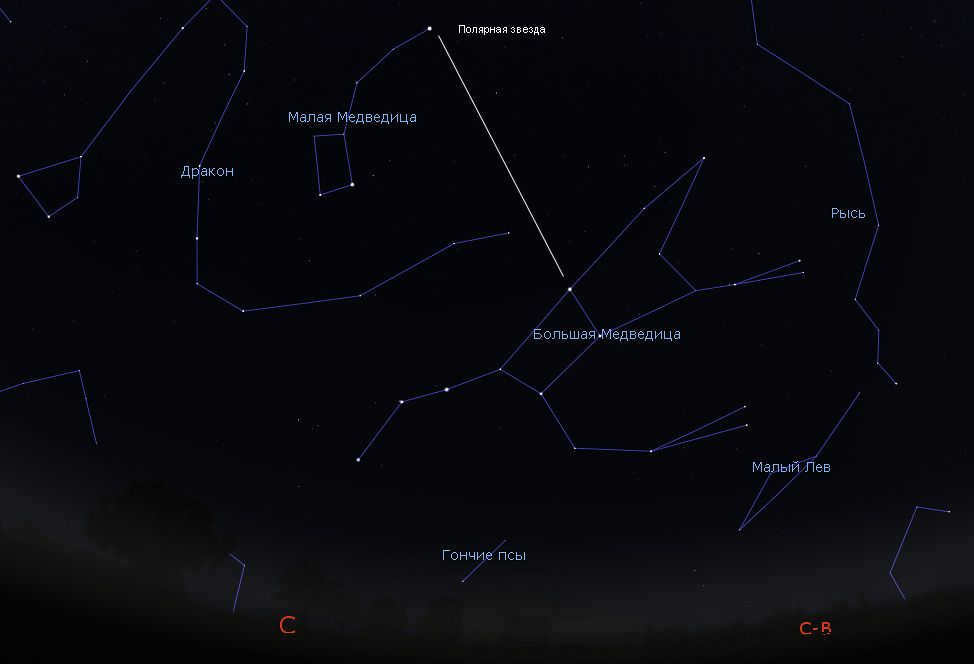
The Big Dipper and Polaris can be observed in the sky during the month of November. This information is provided by Stellarium, a software tool for exploring the night sky.
Now, let’s direct our attention towards the northeast. In this direction, the Big Dipper is still prominent during the middle of the night. However, its position in the sky has undergone some changes compared to the evening sky. Firstly, the dipper has shifted towards the east, and secondly, it has tilted significantly towards the horizon. The dipper now appears with its handle pointing downward and the bucket pointing upwards towards the zenith.
The November 2019 Morning Sky Full of Stars
Let’s take a moment to appreciate the breathtaking view of the starry sky in November, right before dawn. During this time of year, the sun rises later, so we have about 6 more hours from midnight until the break of dawn. As a result, the constellations in the sky will have shifted approximately 90° from their midnight positions and around 180° from their evening positions.
In the western part of the sky, we can observe the prominent winter constellations. Taurus, Orion, Eridanus, and Gemini all gracefully descend towards the horizon. One particular star, Sirius, stands out with its dazzling brightness and captivating display of various colors in the southwest direction.
The Spring Constellations and the Magnificent Leo
As we move into the spring season, a spectacular display of constellations awaits us in the southern sky. Among these celestial wonders, there is one that stands out even in the glow of city lights – the magnificent Leo constellation. Dominating the scene is a remarkable figure composed of four stars forming a trapezoid shape. Located in the lower right corner of this trapezoid is the illustrious Regulus, which not only represents the brightest star in the constellation but also ranks as the twentieth brightest star in the night sky. Regulus also holds a special place as it serves as the foundation for the asterism known as the Sickle, which, when combined with the trapezoid, forms the head and torso of the celestial lion.
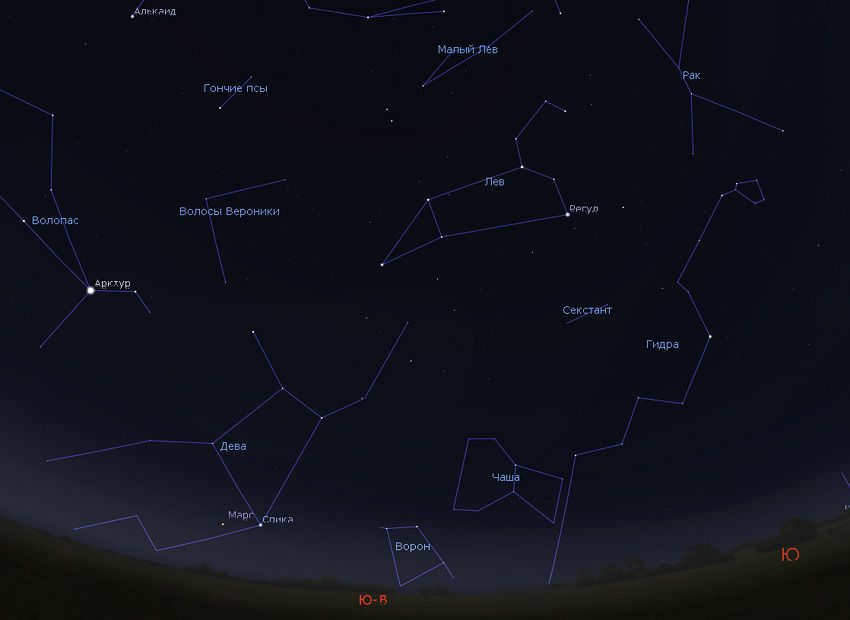

A photograph taken in November 2019 captures the breathtaking beauty of the dawn sky, adorned with countless stars. Looking towards the eastern and southeastern directions, one can observe the celestial bodies in all their glory. Notably, the image features the planet Mars, positioned in close proximity to Spica – one of the three most prominent stars visible in the spring sky. This stunning visual is courtesy of Stellarium, a renowned astronomical software.
Leo, the lion-shaped constellation, dominates the spring sky with its striking presence. By starting from Regulus, the brightest star in Leo, one can navigate their way to Alfard, located in the constellation of Hydra. Positioned between Regulus and Gemini is Cancer – another constellation worth exploring. As one’s gaze descends below the trapezoid-shaped Leo, they will discover the constellations of the Bowl and the Raven, seemingly resting near the horizon.
A sparkling star shines brightly in the eastern sky. It’s the well-known Arcturus that descends below the horizon in the northwest during the evenings. The Virgo constellation, led by Spica, can be seen low above the horizon in the southeast. In November 2019, near Spica, we can find the planet Mars, although it currently appears as a second magnitude star.
Regulus, Spica, and Arcturus are the prominent stars in the southeastern part of the sky before dawn in November. However, in the north, two brilliant stars hang very close to the horizon. These stars are Vega and Deneb, the stars that form the Summer Triangle. In most of Russia, both stars never fully set (except in the southern regions). The Big Dipper is almost directly overhead in the morning.
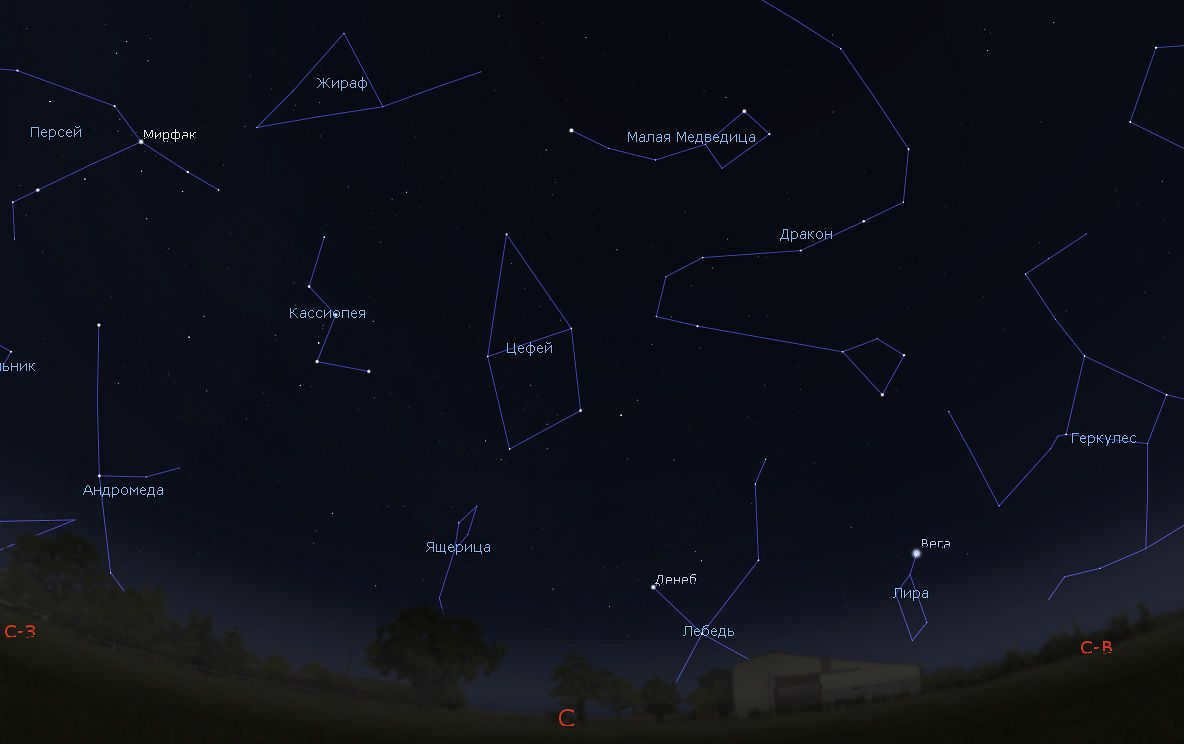
In the month of November, when you look up at the morning sky, you can see a beautiful display of stars. This breathtaking view is captured in the image above, taken with the help of Stellarium. The stars are visible in the northern direction, creating a mesmerizing sight for anyone who takes the time to appreciate it.
Summary
So, our examination of the celestial dome in November 2019 is now complete. How does it differ from the celestial dome of other years like 2010 or 2020? Firstly, the arrangement of the planets in the sky can cause some confusion in terms of the precise depiction of the constellations. This year, both Jupiter and Saturn are visible in the evening sky during November. Towards the end of November, they will be accompanied by the incredibly bright planet Venus. In the morning sky, Mars is not currently attracting much attention. However, on November 20th, Mercury will join Mars, and together with the star Spica, they will form a wonderfully symmetrical line in the pre-dawn sky. On November 24th and 25th, 2019, the Moon will also join this celestial lineup.
That concludes our report for now. We hope you have clear skies and enjoy observing the wonders of the universe!
The astronomical calendar for November 2020 is just as exciting as the one in October. As we approach winter, there are numerous new constellations and celestial objects to observe. One of the highlights is the magnificent Orion constellation, which will be visible in all its glory.
In addition to Orion, there are many other constellations that will sparkle in the night sky, offering a plethora of interesting objects to observe. The winter constellations, in particular, are known for their abundance of sights, and many of them will already be visible in November. The best part is that November isn’t too cold yet, allowing you to spend more time outside enjoying the wonders of the cosmos.
Notable Dates in November
November is a month filled with significant dates commemorating important events and people. It is a month that saw the birth of many renowned individuals such as Edmund Halley, William Herschel, Carl Sagan, Mikhail Vasilyevich Lomonosov, Edwin Hubble, and Anders Celsius.
Another notable event that took place in November was the publication of Einstein’s General Theory of Relativity, which happened 105 years ago.
One particular date that stands out is November 3, 1957, marking the launch of the Sputnik-2 spacecraft. This historic mission carried the first warm-blooded creature, Laika the dog, into space, marking the beginning of the era of crewed space flights.
On November 10, 1970, the renowned “Lunokhod-1” commenced its operations. This day is also recognized as World Science Day and World Youth Day.
November 24, 1971 witnessed the historic moment when the Soviet automatic station Mars-2 successfully made contact with the surface of Mars for the very first time.
November 12, 2014 marked the remarkable event of the Philae module achieving a gentle touchdown on a comet. This groundbreaking mission was conducted on comet 67P/Churyumov-Gerasimenko.
November’s Stunning Night Sky
During the month of November, the night sky becomes a breathtaking spectacle. Gone are the obstacles of bad weather that hindered observations in September and October. The crisp, frosty nights and the clear atmosphere create the perfect conditions to marvel at the winter constellations.
Look to the east and you’ll spot the constellation Leo, adorned with its brilliant star, Regulus. The Big Dipper steadily ascends higher and higher in the sky. And if you gaze towards the northwest, you’ll witness the constellations Lyra and Swan gracefully nearing the horizon.
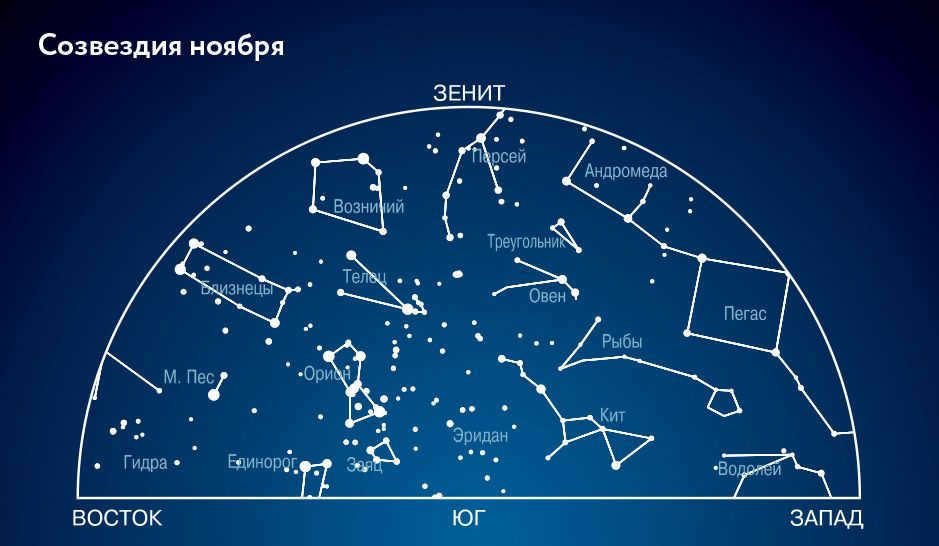
In November, the night sky in the southern hemisphere offers a stunning display of constellations. One of the prominent constellations is Perseus, which is almost at its zenith. Just below Perseus, we can also observe the constellation Taurus, which is also positioned high in the sky. Moving towards the southwest, we can spot Pegasus and Andromeda, both of which are high above the horizon. Additionally, in close proximity to Pegasus and Andromeda, we can find the constellation Whale. If we shift our gaze towards the southeast, we can witness Gemini and the Little Dog. Below Gemini, we can already catch a glimpse of the Big Dog and the bright star Sirius. Last but not least, the constellation Orion stands tall in the sky, offering a plethora of fascinating celestial objects. From the mesmerizing red giant Betelgeuse to numerous captivating nebulae, Orion never fails to captivate stargazers.
Astronomical events in November 2020
This compilation of astronomical events has been curated by astronet.ru.
1.11 – The Moon will pass (F= 1.0) to the south of Uranus.
2.11 – The Moon will pass (F= 0.96-) to the south of the Pleiades.
3.11 – There will be an 8-second occultation of the star HIP 31816 (7.6m) from the constellation of Ascendant by the asteroid (519). This event can be observed from Baikal to the Baltic.
3.11 – The Moon will pass (F= 0.94-) to the north of the Hyades and Aldebaran.
3.11 – The Moon will occult (F= 0.90-) the star Iota Taurus (4.6m). This event will be visible in Northern Russia.
3.11 – Mercury will end its retrograde motion and transition from sideways to direct motion.
4.11 – The Moon will be in the ascending node of its orbit (F= 0.90-).
5.11 – The Moon (F= 0.76-) moves past the maximum declination point north of the celestial Equator.
6.11 – The long-period variable star RS Libra reaches its peak brightness (6.5m).
6.11 – The Moon partially covers the star Omega Gemini (5.2m) when it is visible in the European part of Russia (F= 0.75-).
7.11 – The Moon partially covers the star gamma Cancer (4.7m) with visibility in most of Russia (F= 0.57-).
7.11 – The Moon passes to the north of the star cluster Nursery (M44) (F= 0.58-).
8.11 – The Moon is in the last quarter phase.
9.11 – The long-period variable star T Dove reaches its maximum brightness (6.5m).
9.11 – The Moon (F= 0.4-) moves north of Regulus.
10.11 – Mercury is currently situated at a westerly elongation of 19 degrees in the morning sky.
12.11 – The variable star X Unicorn is currently shining at its maximum luminosity of 6.5m.
12.11 – The Moon will pass north of Venus, with a magnitude of 0.08-.
13.11 – The Moon will pass north of Spica, with a magnitude of 0.07-.
13.11 – The Moon will pass north of Mercury, with a magnitude of 0.03-.
14.11 – The Moon will be at its perigee, with a distance of 357,841 km from the center of the Earth, and a magnitude of 0.01-.
15.11 – It will be a New Moon on this day.
15.11 – Mars will transition from sideways motion to direct motion on this day.
16.11 – The Moon will pass north of Antares, with a magnitude of 0.02+.
17.11 – The Moon will be in the descending node of its orbit, with a magnitude of 0.05+.
17.11 – The Leonids meteor shower will reach its peak with a Zenithal Hourly Rate (ZHR) of 20.
18.11 – The Moon will pass through the point of maximum declination south of the celestial Equator, with an illumination fraction (F) of 0.14+.
19.11 – The Moon will be near Jupiter and Saturn, with an illumination fraction (F) of 0.23+.
20.11 – The long-period variable star R Cassiopeia will be near its maximum luminosity of 6m.
22.11 – The Moon will be in the first quarter phase.
23.11 – The Moon will pass south of Neptune, with an illumination fraction (F) of 0.63+.
24.11 – The long-period variable star R Hare will be near its maximum luminosity of 6m.
25.11 – The long-period variable star X of Serpentor will be near its maximum luminosity of 6m.
25.11 – The Moon will be near Mars, with an illumination fraction (F) of 0.82+.
25.11 – The long-period variable star T Cassiopeia is currently at its maximum luminosity (6.5m).
26.11 – The star Nu Pisces (4.5m) will be partially covered by the Moon (F = 0.88+). This event can be observed in most parts of Russia.
27.11 – The Moon (F= 0.90+) will be at the farthest point in its orbit from the center of the Earth, known as the apogee. It will be approximately 405,892 km away.
27.11 – The Moon (F= 0.93+) will pass to the south of Uranus.
29.11 – Neptune will transition from sideways to direct motion, known as its standing position.
30.11 – It will be a full moon on this day.
30.11 – A penumbral eclipse of the Moon will be visible in South America, Australia, and Asia.
30.11 – The Moon (F= 1.0) will pass to the north of the Hyades and Aldebaran.
Moon Phases in November 2020
The moon will go through the following phases in November:
November 8th – Third Quarter.
November 15th – New Moon.
November 22nd – First Quarter.
November 30th – Full Moon.
Additionally, there will be a penumbral lunar eclipse on November 30th. The eclipse will begin at 12:32 Moscow time and will last for 4 hours and 20 minutes. This phenomenon will be visible in South America, Australia, and Asia, but not in Russia. It will be the final lunar eclipse of 2020.
Planets in November 2020
Observing the planets can be done during the following times:
Evening – Jupiter, Saturn, Mars, Uranus, Neptune.
Mercury will be visible in the eastern sky just before dawn from November 3-4, but it will be very close to the horizon. The greatest elongation will occur on November 10, measuring 19.1 degrees. Throughout the month, the brightness of Mercury will range from +1.5 m to -0.7 m, and its apparent size will vary from 9 to 5″. The luminosity of the Mercury’s disk will change from 14.6% to 95%.
Venus will be visible in the eastern sky closer to midnight and into the morning hours in November. The brilliance of Venus will change from -4.0 to -3.9 m, the diameter from 13.1 to 11.7″, and the disk illuminance will change from 81.4% to 88.5%.
Jupiter can be observed in the evening sky in November, appearing low above the horizon in the southern direction. It will set quickly, changing its apparent diameter from 36.9 to 34.4″ and its luminosity from -2.1 to -2 m.
Saturn will also be visible in the southern part of the sky, appearing low above the horizon. Its brightness will change from +0.59 to +0.64 m, and its diameter will change from 36.9 to 34.4″. The visible size of Saturn, including its rings, will be approximately 34.4″.
Uranus will also be visible in the southern part of the sky, appearing high above the horizon in the constellation Aries. Its brightness will change from 5.66 to 5.68 m, and its diameter will change from 3.76 to 3.73″.
Neptune can be found in the constellation Aquarius, appearing high in the southern part of the sky. Its brightness will range from +7.84 to 7.88 m, and its diameter will range from 3.30 to 3.34″.
Space travel in November 2020
There are several space events scheduled for November:
3.11 – A Soyuz rocket from Arianespace will launch at the French Guiana Space Center at 01:33 GMT. It will carry the Falcon Eye 2 satellite for the UAE, which will capture images of the Earth.
10.11 – SpaceX’s Falcon 9 rocket will launch from Vandenberg Base in California at 19:45 GMT. It will deploy the Sentinel 6A satellite, a collaborative project involving NASA, the European Space Agency, and others. The satellite will investigate changes in sea level.
22.11 – A Falcon 9 rocket will launch from Cape Canaveral. The Dragon spacecraft will transport another shipment of supplies to the International Space Station.
24.11 – The Angara-5A rocket will conduct its second test flight in orbit from Russia’s Plesetsk Cosmodrome.
On November 30th, a Falcon 9 rocket is scheduled to launch the Turkish communications satellite Turksat 5A into orbit from Cape Canaveral.
There are also other upcoming flights. In November, SpaceX plans to send a crewed spacecraft, the Crew Dragon, with four astronauts on board to the International Space Station (ISS). These astronauts will be put into orbit using the same Falcon 9 rocket.
Furthermore, SpaceX has scheduled another launch in November for their “steam train” of Starlink satellites. This project, led by Elon Musk, aims to provide global internet coverage and will require approximately 12,000 satellites. The launch will consist of 14 batches, with each batch containing 60 communication satellites.
In addition to SpaceX’s launches, India is planning to launch their own Earth observation radar satellite, RISAT 2BR2, in November. This satellite will be launched using a rocket from the Satish Dhawan Space Center.
Apocalypse of the month
What kind of doomsday scenario awaits us in November 2020? Surprisingly, this time it won’t involve the dreaded planet Nibiru, extraterrestrial beings, or even a mundane asteroid. Instead, our trusty neighbor, the Moon, will be the cause of our unexpected demise. It will inexplicably veer off its orbit, triggering cataclysmic events that will lead to our destruction. Brace yourselves, for the Moon is on a collision course with Earth. I suppose it’s only fitting that a tumultuous year like this would end with something utterly bizarre and monumental. It was bound to be one for the books.

Fortunately, there won’t be a full moon on November 23!
We can only marvel at the creativity of conspiracy theorists, but just to be safe, don’t forget to make your loan and mortgage payments! What if the apocalypse gets postponed again?
Before the Moon decides to obliterate life on Earth, take some time to appreciate the winter constellations of November and we hope you have many clear and warm nights.
Operating hours: 10:00 a.m. to 9:00 p.m.,
Closed on Tuesdays
“Retro Cafe”: open during Planetarium operating hours from 10:00 to 20:00.
+7 (495) 221-76-90
Planetarium JSC © 2017. Moscow, Sadovaya-Kudrinskaya str. 5, bldg. 1
November 2021 Astrological Predictions
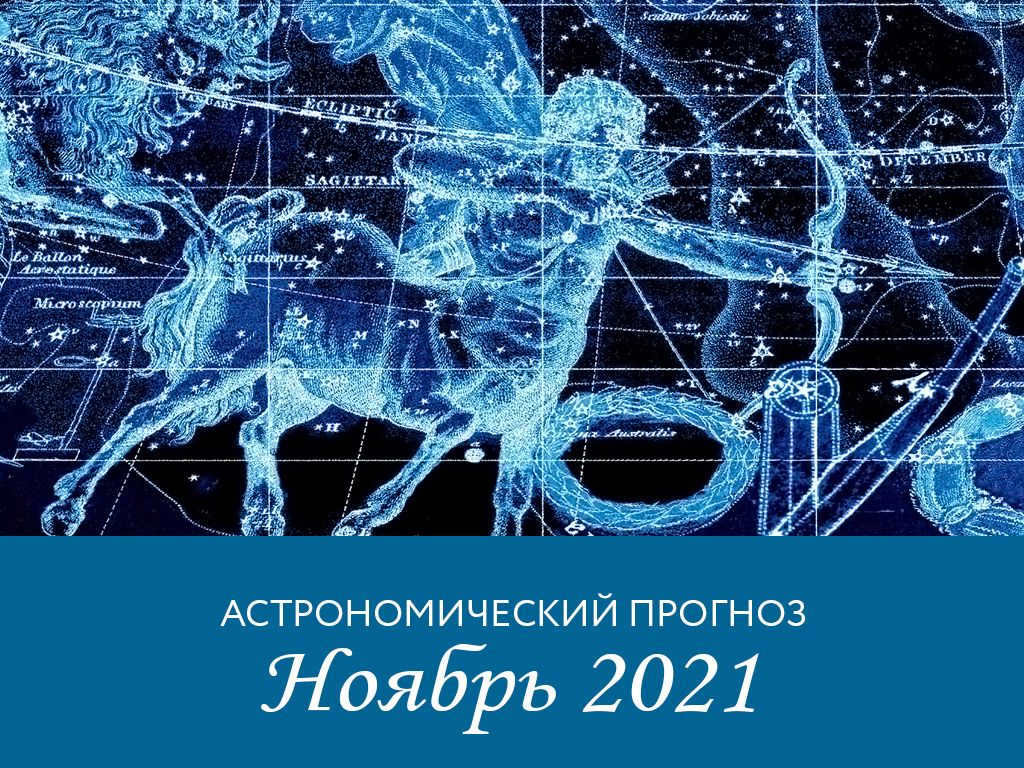
Date: 27.10.2021
On November 5th, the Moscow Planetarium will celebrate its 92nd anniversary!
November 10th is a day to celebrate World Science Day and World Youth Day.
On November 19th, on the 310th anniversary of Mikhail Vasilyevich Lomonosov, there will be an almost total eclipse of the Moon visible in eastern Russia.
So, in early November, Uranus will be in opposition to the Sun. In the middle of the month, we can look forward to the famous “starfall” from the constellation of Leo – Leonidas, as well as the eclipse of the Moon. And at the end of the month, Mercury will hide in the rays of the Sun as it enters conjunction with it.
On November 19, there will be a partial eclipse of the Moon with a maximum phase of 0.97 at 12:04 Moscow time. The Moon will traverse the southern part of the Earth’s shadow. The duration of the eclipse will be 3 hours and 28 minutes (from 10:20 MSK to 13:48 MSK), and during the peak phase at 12:04 MSK, the Moon will appear almost completely obscured (0.97) with its southern edge brightly illuminated. Observers in the eastern regions of our country will be able to see the shadow phases (from 07:17 to 10:48). The entire shadow eclipse will be visible in the Far Eastern Federal District in the evening. The eclipse will not be visible in Moscow as the Moon will be below the horizon during that time.
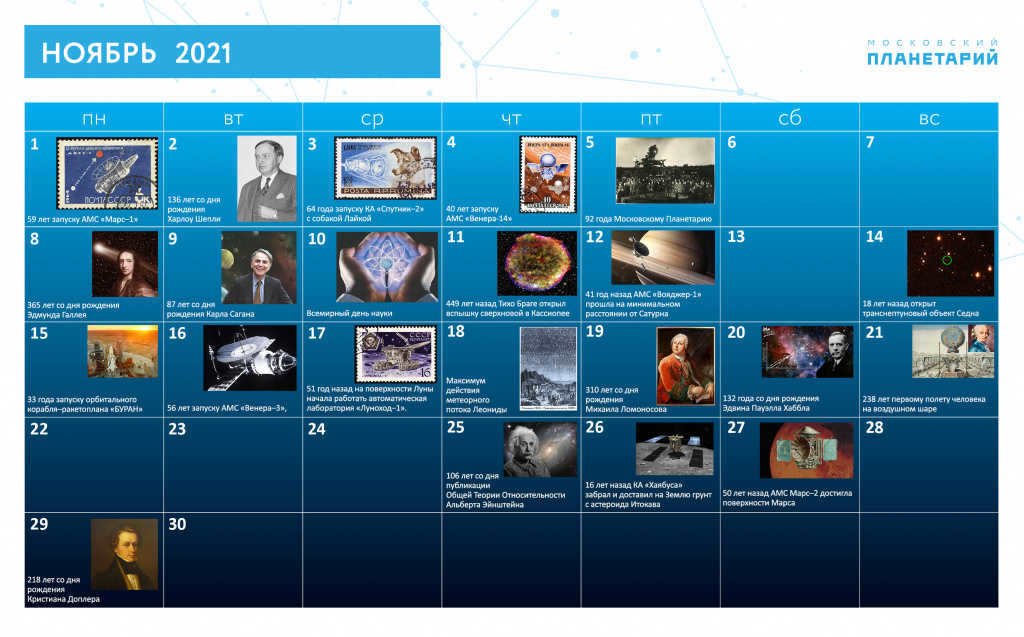
Calendar for November 2021
Notable dates and events in astronomy and astronautics for November 2021:
November 4 – 40th Anniversary 40 years ago, in 1981, the Automated Interplanetary Station (AIS) known as “Venus-14” was launched. The landing site was captured in a color panorama and soil samples were collected from the descent vehicle (RV) for chemical analysis.
November 5 – 92nd Anniversary of Moscow Planetarium! On November 5, 1929, the first large planetarium in the USSR and the 13th in the world opened in Moscow.
25 years ago on November 7, in 1996, the “Martian Topographer” – Mars Global Surveyor – was launched. This NASA project aimed to study Mars and became one of their most successful ones. The spacecraft traveled an impressive distance of 750 million km in just 300 days and finally reached Mars on September 11, 1997. By March 1999, it had settled into a circular polar orbit at an altitude of 378 kilometers, which proved to be ideal for mapping the Martian surface.
45 years ago on November 7, in 1976, the Cosmonaut Training Center (CTC) established the first group of foreign cosmonauts. This initiative was part of the Intercosmos program and aimed to train astronauts from other countries for spaceflight missions.
365 years have passed since the birth of Edmund Halley (8.11.1656 – 14.01.1742) – an English Royal Astronomer, geophysicist, mathematician, meteorologist, physicist, and demographer. The return of the comet on the predicted date was the first successful confirmation of Newton’s theory of gravitation and brought fame to Halley. Today, this comet is known as 1P/Halley or Halley’s comet.
World Science Day and World Youth Day are celebrated on November 10.
55 years ago, in 1966, Earth witnessed the most powerful meteor shower of all time called Leonids. On that night, there were up to 10,000 meteors per hour, which means 2-3 meteors per second!
310 years have passed since the birth of the renowned Russian scientist-encyclopedist, Mikhail Vasilyevich Lomonosov (19.11.1711 – 15.04.1765), who laid the foundation for numerous branches of Russian science. In 1745, he was elected as an academician of the St. Petersburg Academy of Sciences, and in 1755, he established Moscow University. One of his notable astronomical achievements was the discovery of Venus’ atmosphere on June 6, 1761.
It has been 320 years since the birth of Anders Celsius (27.11.1701 – 25.04.1744), the Swedish astronomer, geologist, and meteorologist (during the 18th century, geology and meteorology were considered part of astronomy). He is credited with creating a new temperature scale that bears his name, which was revolutionary for his time.
November 27 – Celebrating 50 years Half a century ago, in 1971, the Mars-2 Automated Interplanetary Station (AMS) accomplished the remarkable feat of being the first spacecraft to successfully land on the surface of Mars.
Astronomical events in November 2021
Throughout this overview, all times mentioned are in Moscow time: T msk = UT + 3h (where UT stands for Universal Time).
The Moon’s various phases are denoted by F (0,0+-): F = 0.00(new moon), F = 0.50+(first quarter), 1.00(full moon), F = 0.50-(last quarter); for celestial bodies – their stellar magnitude (+-0.0m)
November 2 – Mercury (- 0.9m) passes 4° north of Spica (+1.0m) (07:00)
November 3 – Moon (F= 0.05-) passes 5° north of Spica (+1.0m) (18:00)
November 3 – Moon (F= 0.05-) passes 1° north of Mercury (- 0.9m) (23:38)
November 4 – Mars (+1.7m) passes 2°17 north of Spica (+1.0m) (07:00)
November 5 – New Moon (00:15)
November 5 – Uranus in opposition to the Sun (03:00)
On November 6, the Leonids meteor shower activity will begin.
On November 6, the Moon (F= 0.02+) will reach the perigee of its orbit (apparent diameter 33’18”) at a distance of 358844 km (01:24)
On November 6, the Moon (F= 0.05+) will pass north of Antares (+1.0m) (22:00)
November 7 marks the end of Mercury’s morning visibility.
November 7 also marks the end of Orionid meteor shower activity.
On November 8, the Moon (F= 0.16+) will pass 0.5° north of Venus (- 4.7m) (07:50)
On November 8, there will be a coverage of Venus (- 4.5m) by the Moon (F= 0.16+) visible in the Russian Far East (08:00)
On November 10, the Moon (F= 0.4+) will be near Jupiter and Saturn – passing 4° south of Saturn (+0.8m) (19:23)
On November 10, Mercury (-0.9m) will come within 1° of Mars (+1.7m).
November 11 will mark the first quarter phase of the Moon (15:48).
On November 11, the Moon (F=0.52+) will be near Jupiter and Saturn, passing 4° south of Jupiter (-2.4m) at 23:16.
November 14 will see the Moon (F=0.73+) pass 4° south of Neptune (+7.9m) at 00:36.
On the night of November 17-18, the Leonids meteor shower is expected to reach its peak, with approximately 15 meteors per hour at the zenith. However, observing the Leonids in 2021 will be challenging due to unfavorable conditions. The almost full Moon (F=0.95+) will significantly interfere with observations.
On November 18, the Moon (F=1.0) will pass 1.5° south of Uranus (+5.7m) at 06:50.
November 19 will bring the Full Moon at 12:00.
On November 19, there will be a private eclipse of the Moon that will be visible in eastern Russia. The maximum phase of the eclipse will be 0.974 and it will occur at 12:04 Moscow time. Unfortunately, the eclipse will not be observable in Moscow.
On November 20, the Moon will pass 6° north of Aldebaran, which has a magnitude of +0.83m. This will occur at 18:51.
On November 21, the Moon will be at the apogee of its orbit, with an apparent diameter of 29’25”. It will be at a distance of 406275 at 05:15.
On November 24, the Moon will pass 2.5° south of Pollux, which has a magnitude of +1.2m. This will occur at 06:00.
On November 27, the Moon will pass 5° north of Regulus, which has a magnitude of +1.35m. This will occur at 05:00.
On November 27, the Moon will be in the last quarter phase at 15:30.
On November 29, Mercury will be in upper (outer) conjunction with the Sun at 08:00.
On November 30, the activity of the Leonids meteor shower will come to an end.
Starry November Nights
The beautiful night sky in November is filled with an array of stars. When the weather is clear and cold, you can gaze upon the bright stars that make up the constellations of winter, shining above the horizon.
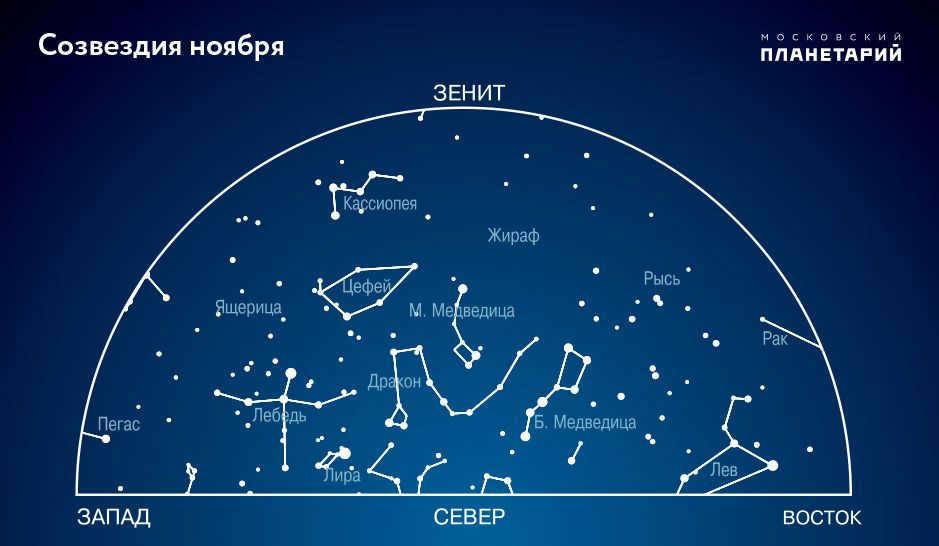
During the month of November, in the late hours of the night, the Leo constellation emerges from the eastern horizon, accompanied by the brilliant star Regulus. Meanwhile, high above the horizon in the northeast, one can spot the prominent Big Dipper. In the northern region, Polaris can easily be located within the Little Dipper and the Dragon. As one gazes upwards, they will notice the distinctive “House” formation of the Cepheus constellation, as well as the inverted “M” shape of Cassiopeia. Towards the northwest, near the horizon, the constellations Lyra and Swan come into view, showcasing the shining brightness of Vega and Deneb.
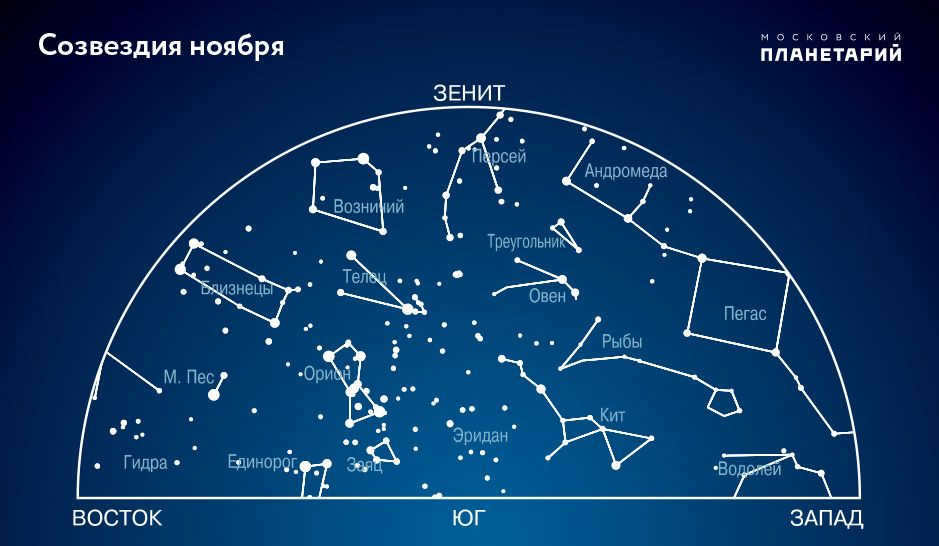
Located in the southern part of the celestial sphere, near the zenith, one can observe the awe-inspiring constellation of Perseus. To the left of Perseus lies the Ascendant, while below it rests the constellation of Taurus. Continuing downwards and towards the east, we encounter the illustrious constellation of Orion, adorned with its brilliant stars: the reddish Betelgeuse and the bluish Rigel and Bellatrix. Moving towards the southwest, one can spot the magnificent constellations of Pegasus and Andromeda, with the celestial giant known as the Whale positioned just below them near the horizon. Shifting our gaze towards the southeast, we are greeted by the lofty presence of Gemini, followed by the Little Dog, accompanied by its radiant star, Procyon. Finally, towards the horizon, we are met with the most brilliant star in the night sky, Sirius, also known as the alpha of the Big Dog constellation.
The Leonids: November’s Spectacular Meteor Shower
From November 6th to the 30th, stargazers can witness the mesmerizing Leonids meteor shower. Named after the constellation of Leo, where its radiant is located, this astronomical event will reach its peak on November 17, 2021. During the night of November 17th to 18th, observers can expect a maximum activity of around 15 meteors per hour at the zenith.
Unfortunately, the observing conditions for the Leonids in 2021 are not ideal. The almost full Moon (F=0.95+), which is approaching its full phase on November 19th, will significantly interfere with observations.
The Leonid meteors are known for their brightness and speed, reaching an impressive velocity of 71 km/sec. To have the best chance of spotting these “shooting stars,” a clear sky without any clouds and minimal lunar illumination are highly recommended.
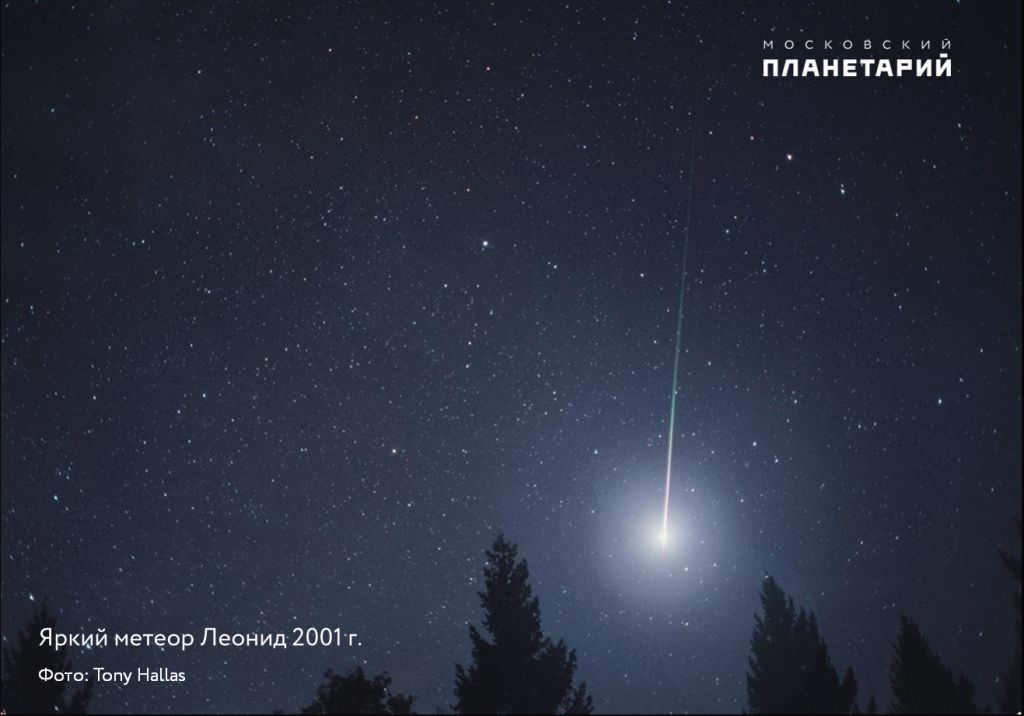
Leonids originate from the remnants of comet 55P/Tempel – Tuttle, which comes close to the Sun every 33 years and consists of fast meteors that appear white. The intensity of the meteor stream varies from year to year, but every 33 years the stream becomes stronger and produces star showers, meteor showers, or even storms, which have been observed in 1833, 1866, 1966, 1999, and 2001. Below are two engravings depicting the meteor storm of the Leonid meteor shower in November 1883.
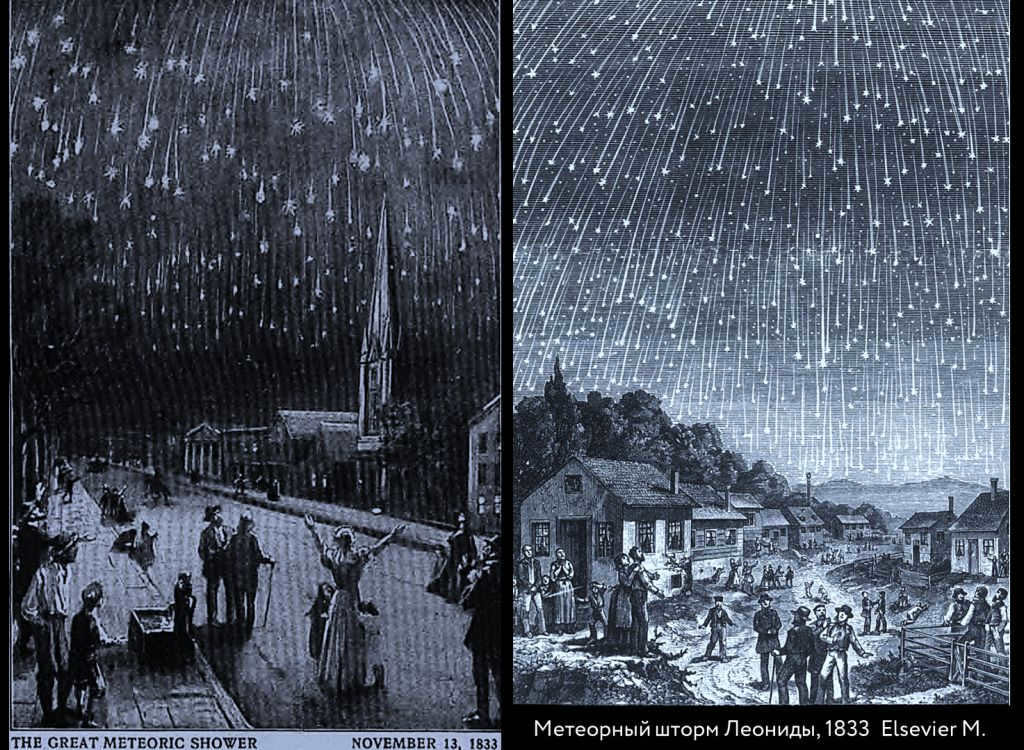
In the year 1966, a spectacular event took place where people witnessed an incredible meteor storm coming from the constellation Leo. Within an hour, an astonishing number of 10,000 meteors were observed, equating to approximately 2 or 3 meteors every second. It truly was a breathtaking sight!
However, it seems that we will have to exercise patience as such a phenomenon may not occur again until the year 2099. According to the International Meteor Organization (IMO, https://www.imo.net), it is predicted that the Earth will not come across the dense clouds of cometary dust that generate these meteor storms until 2099. Therefore, when the comet makes its return to the Sun in 2031 and 2064, meteor storms are not anticipated. However, there may be a slight increase in Leonid activity to around 100 meteors per hour. In the meantime, until 2030, it is predicted that activity peaks will reach about 15-20 meteors per hour.
Sun
The sun is a star located at the center of the solar system. It is a ball of hot, glowing gases that provides light and heat to the planets in the system. The sun is essential for life on Earth as it enables photosynthesis, which is the process by which plants convert sunlight into energy. Without the sun, life as we know it would not exist. The sun is also a source of renewable energy, with solar power becoming increasingly popular as a clean and sustainable alternative to fossil fuels. It is fascinating to think about the immense power and energy that the sun holds, and its importance to our existence.
The Sun will transition from the constellation Libra to Scorpio on November 23 and then move into the constellation Serpentor on November 29. By the end of November, the Sun will have a declination of 21.5 degrees south of the celestial equator, resulting in the shortest days of the year in the northern hemisphere. In Moscow, the duration of daylight will decrease from 9 hours 12 minutes at the beginning of the month to 7.5 hours by the end, just half an hour longer than the minimum. It is possible to observe the Sun on clear days, but it is important to use a solar filter when using telescopes or other optical devices (for more information, see the journal “Nebosvod” at http://astronet.ru/db/msg/1222232).
There will be a private shadow eclipse of the Moon on November 19, 2021, which will not be visible in Moscow.
Solar and lunar eclipses happen every six months, with a two-week gap between them. These celestial events occur when the Sun, Earth, and Moon align in a straight line. If the Moon is in the middle, a solar eclipse is observed, while a lunar eclipse is observed if the Earth is in the middle.
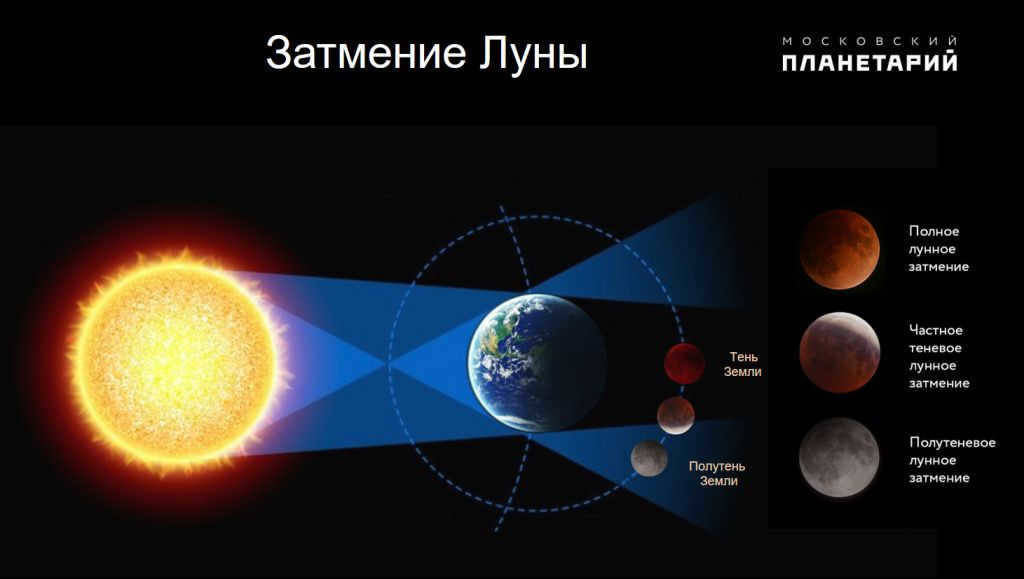

Full moon is the time when lunar eclipses occur, as the Earth is positioned between the Sun and the Moon on the same line. When the Moon enters the Earth’s shadow and takes on a reddish tint, it is referred to as a total eclipse of the Moon. However, there are also partial shadow lunar eclipses, where the Moon does not fully enter the Earth’s shadow.
Circumstances of the Moon’s eclipse visibility on 19.11.2021
On the 19th of November, 2021, a partial lunar eclipse will take place. The lunar disk will enter the Earth’s shadow at 12:04 Moscow time, with 0.97 of its surface being covered. It is worth noting that almost the entire Moon will be immersed in the Earth’s shadow. This eclipse can be referred to as an “almost total” lunar eclipse, as the majority of the lunar disk will take on a reddish tint. Only individuals residing in the Far Eastern regions of our nation will have the opportunity to witness this phenomenon. They will have the chance to observe both the maximum and partial phases of this eclipse.
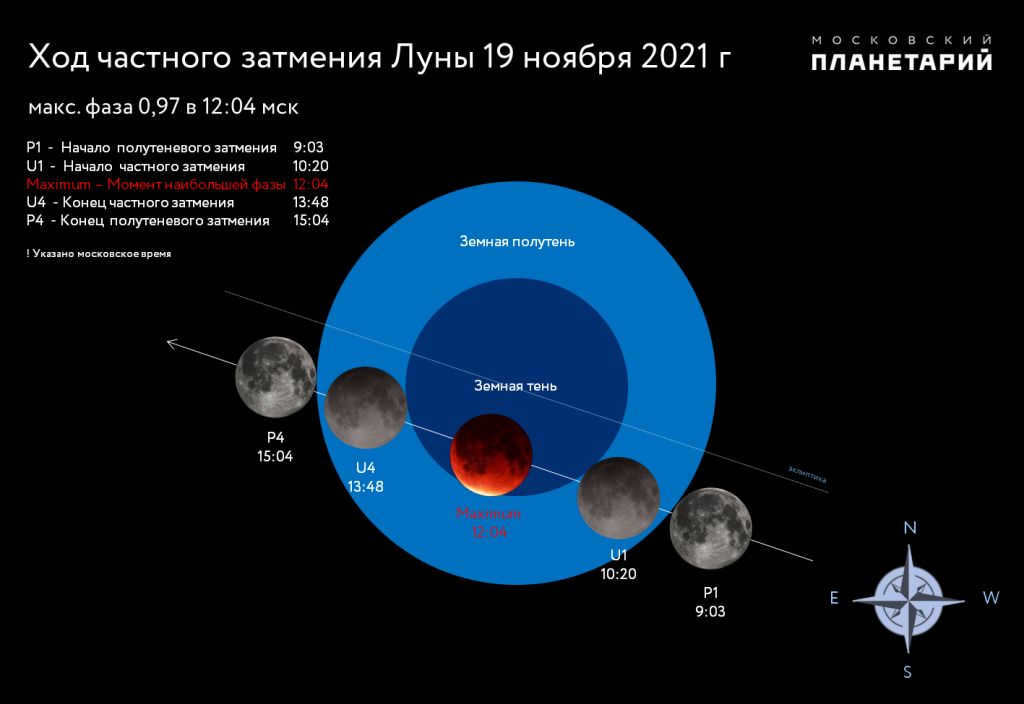
The circumstances are not favorable for observing this eclipse in Russia. In Moscow, it will be impossible to witness the eclipse as the Moon will be situated below the horizon during the event.
The shadow eclipse will be visible in the evening from the start to the finish in the Far Eastern Federal District.
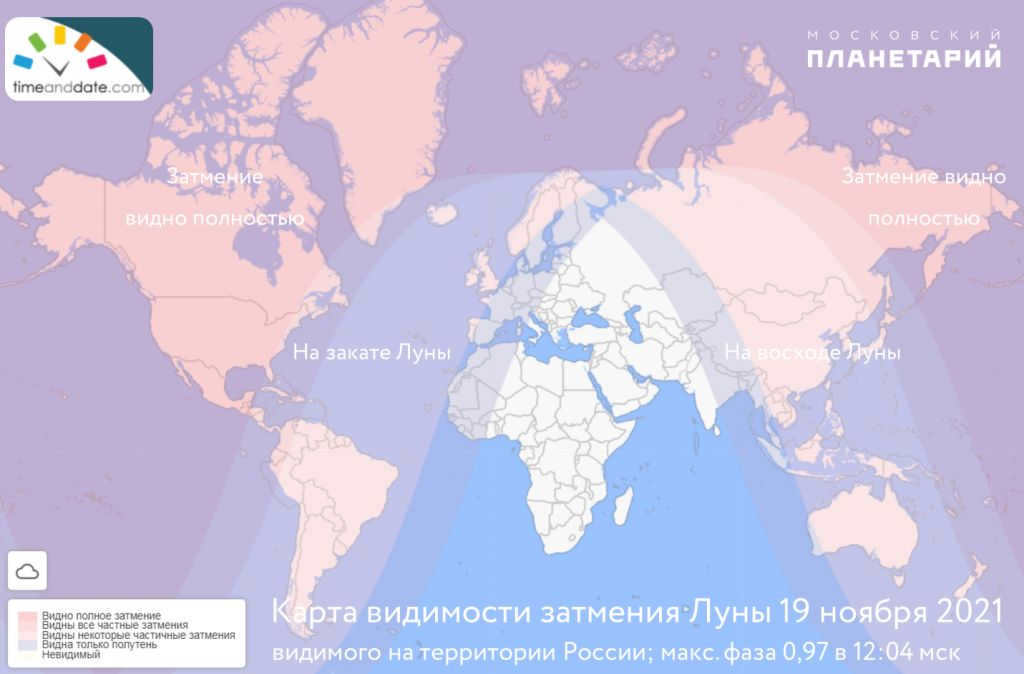
Unfortunately, the conditions for observing this eclipse are not favorable in most parts of our country. This is because the eclipse occurs during the daytime when the Moon is not visible above the horizon.
However, there is still a chance to witness the greatest phase of the eclipse, which will be almost total (0.97), in the Transbaikal regions. The end of the eclipse can also be observed in central, eastern, and northern Siberia. It is important to note that in these regions, the eclipse will occur in the early evening. During this time, the Moon’s brightness will be significantly diminished, but it will still be visible low above the horizon in the still bright sky.
The lunar eclipse on November 19, 2021 will take place in the western part of the Taurus constellation, near the Pleiades star cluster. The Moon will pass through the southern portion of Earth’s shadow. The eclipse will last for a duration of 3 hours and 28 minutes, starting from 10:20am and ending at 1:48pm. At its peak phase, which will occur at 12:04pm, the Moon will appear almost completely eclipsed, with its southern edge illuminated. The outer regions of the shadow are expected to have a bluish tint due to the absorption of light by ozone in the Earth’s southern polar regions.
*To find out the specific start time and path of the lunar eclipse on November 19, 2021 for a particular location on Earth, you can refer to the interactive map provided by Xavier M. Jubier: http://xjubier.free.fr/site_pages/lunar_eclipses/xLE_GoogleMap3.php?Ecl=+20211119&Acc=2&.
Forecast of magnetic storms in November 2021
The Moon and planets
Moon phases in November 2021:
On November 6, the Moon (F= 0.02+) will be at the perigee of its orbit at a distance of 358,844 km (01:24).
On November 11, the Moon will be in the first quarter phase (15:48).
On November 19, there will be a Full Moon (12:00).
On November 21, the Moon (F= 0.98-) will be at the apogee of its orbit at a distance of 406,275 km (05:15).
On November 27, the Moon will be in the last quarter phase (15:30).
On November 19, 2021, there will be a penumbral eclipse of the Moon visible in eastern Russia. The maximum phase is 0.97 at 12:04 Moscow time. This eclipse is not observable in Moscow.
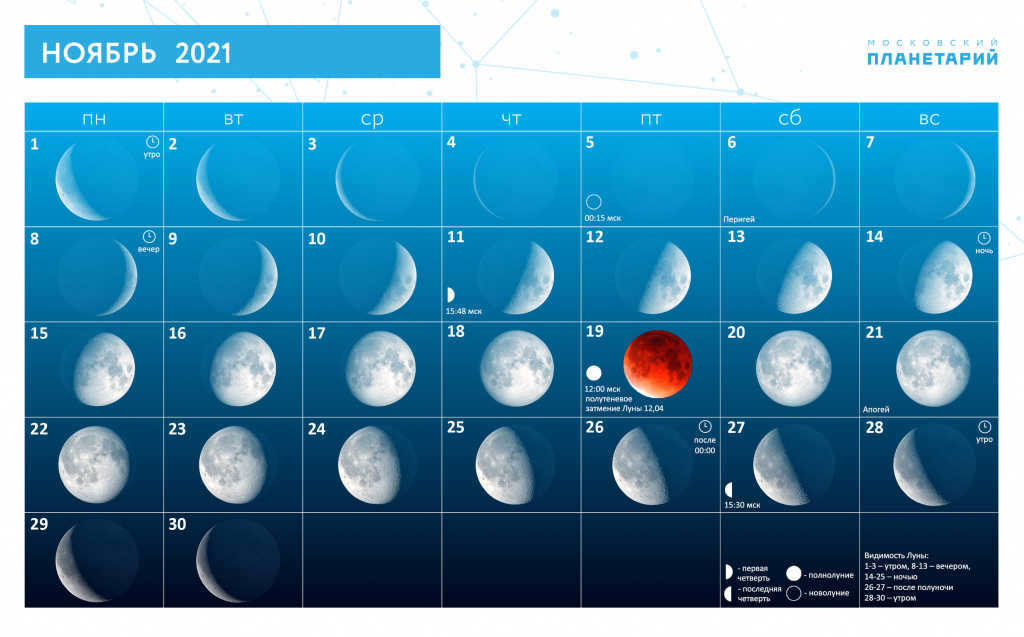
Visibility of the Moon in November 2021 (numerically):
Alignments of the Moon with planets and prominent stars:
On November 3rd, the Moon (F= 0.05-) will pass 5 degrees north of Spica (+1.0m) at 18:00.
On November 3rd, the Moon (F= 0.05-) will pass 1 degree north of Mercury (- 0.9m) at 23:38.
On November 6th, the Moon (F= 0.05+) will pass north of Antares (+1.0m) at 22:00.
On November 8th, the Moon (F= 0.16+) will pass 0.5 degrees north of Venus (- 4.7m) at 07:50.
On November 8th, the coverage of Venus (- 4.5m) by the Moon (F= 0.16+) will be visible in the Russian Far East at 08:00.
On November 10th, the Moon (F= 0.4+) will be near Jupiter and Saturn – it will pass 4 degrees south of Saturn (+0.8m) at 19:23.
On November 11, the Moon with a magnitude of 0.52+ will be passing 4 degrees south of Jupiter, which has a magnitude of -2.4m. This event will occur at 23:16.
On November 14, the Moon with a magnitude of 0.73+ will be passing 4 degrees south of Neptune, which has a magnitude of +7.9m. This event will occur at 00:36.
On November 18, the Moon with a magnitude of 1.0 will be passing 1.5 degrees south of Uranus, which has a magnitude of +5.7m. This event will occur at 06:50.
On November 20, the Moon with a magnitude of 0.99- will be passing 6 degrees north of Aldebaran, which has a magnitude of +0.83m. This event will occur at 18:51.
On November 24, the Moon with a magnitude of 0.81- will be passing 2.5 degrees south of Pollux, which has a magnitude of +1.2m. This event will occur at 06:00.
On November 27, the Moon with a magnitude of 0.56- will be passing 5 degrees north of Regulus, which has a magnitude of +1.35m. This event will occur at 05:00.
Planetary Events in November 2021:
On November 2, Mercury (-0.9m) will pass 4 degrees north of Spica (+1.0m) at 07:00.
On November 4, Mars (+1.7m) will pass 2 degrees 17 minutes north of Spica (+1.0m) at 07:00.
On November 5, Uranus will be in opposition to the Sun at 03:00.
On November 7, Mercury’s morning visibility will come to an end.
On November 8, Venus (-4.5m) will be covered by the Moon (F=0.16+) and will be visible in the Russian Far East at 08:00.
On November 10, Mercury (-0.9m) will pass within 1 degree of Mars (+1.7m).
On November 29, Mercury will be in an upper (outer) conjunction with the Sun at 08:00.
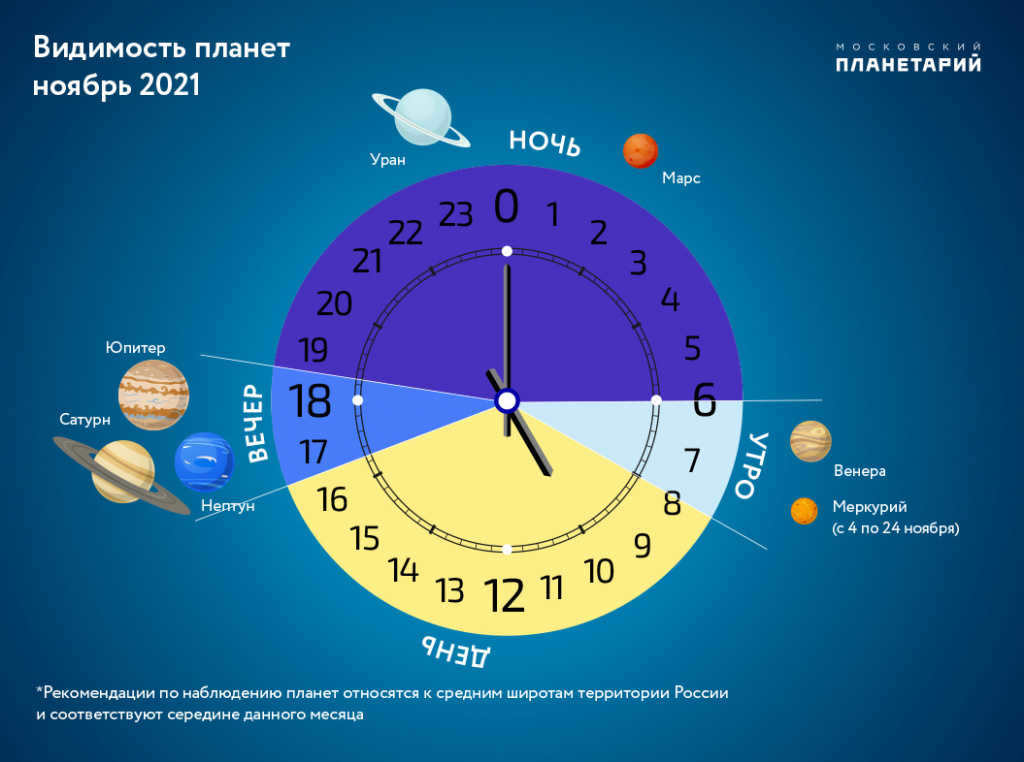
Observing the Planets in November 2021:
On November 5, Uranus will reach opposition to the Sun, making it easily visible through a telescope throughout the entire month.
Mercury (-1.0): By the conclusion of November (November 29), Mercury will align with the Sun in an upper conjunction. Consequently, it will only be visible during the early and mid-morning hours, near the horizon in the southeast, and for a maximum of one hour. It will be located in the constellations Virgo and Libra.
Venus(-4.8): In the evening, it can be observed near the southern horizon in the constellation Sagittarius.
Mars (1.7): In the morning, it can be seen near the southeast horizon, amidst the backdrop of the dawn sky, in the constellations Virgo and Libra.
Jupiter (-2.2): During the evening and night, it will be positioned in the constellation Capricorn.
Saturn(0.8): During the evening and night, it will be situated in the constellation Capricorn.
Uranus(5.5): At the start of the month, it will be visible throughout the night in the constellation Aries. In the middle and end of the month, it can be observed during the evening and night. Neptune(7,9) : During the evening and night, it will be located in the constellation Aquarius.
What can be observed through a telescope in November?
Double stars: In November, telescope owners will have the opportunity to observe various double stars in the sky, including θ Taurus, η Perseus, γ Andromeda, and η Cassiopeia.
Variable stars: The month of November also offers the chance to observe several variable stars through a telescope, such as ζ of Gemini, δ of Cepheus, β of Perseus, and λ of Taurus.
Scattered star clusters: There are several scattered star clusters that can be observed in November, including Crèche in the constellation Cancer, M35 in Gemini, Pleiades in Taurus, M39 in Swan, and h and χ of Perseus.
Nebulae: Two notable nebulae that can be observed in November are M1 in the constellation Taurus and M42 in the constellation Orion.
Galaxies: November offers the opportunity to observe several galaxies through a telescope, including M31 in the constellation Andromeda, M33 in the constellation Triangle, and M81 and M82 in the constellation Big Dipper.
These observations are specific to the middle latitudes of Russia and are most suitable for midnight during the middle of November.
Working hours: 10:00 AM to 9:00 PM,
Closed on Tuesdays
“Retro Café”: open from 10:00 AM to 8:00 PM on days when the Planetarium is open.
Contact number: +7 (495) 221-76-90
Planetarium JSC © 2017. Moscow, Sadovaya-Kudrinskaya str. 5, bldg. 1
Astronomical forecast for November 2020
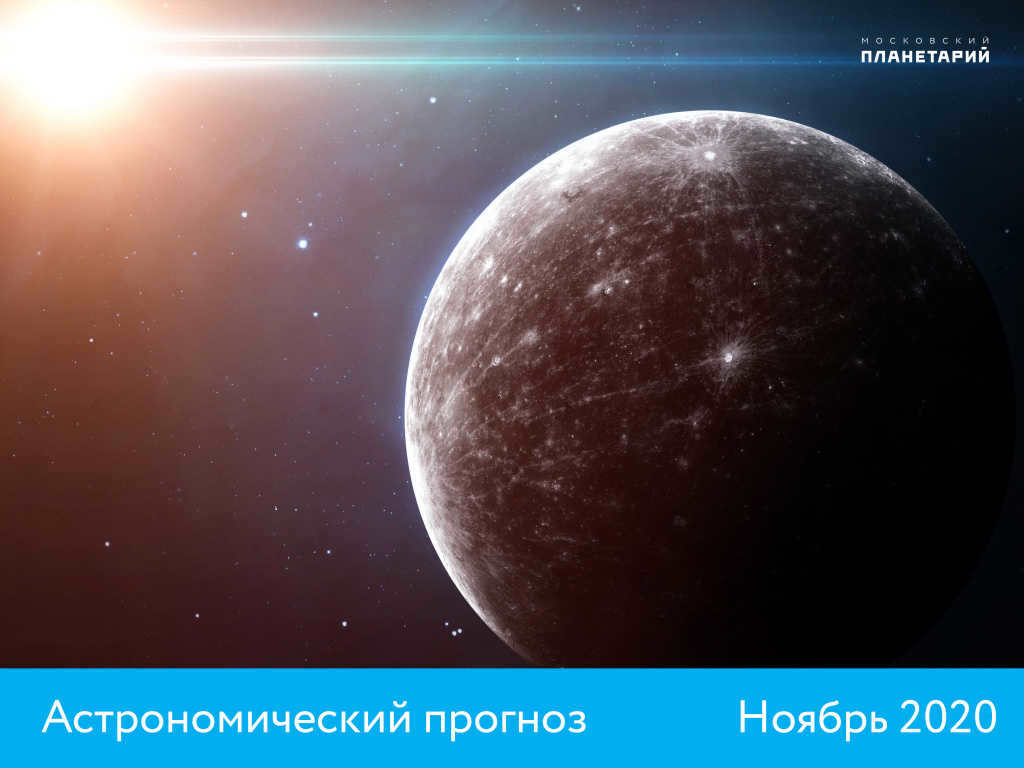
Date: 29th October 2020
The Moscow Planetarium will be celebrating its 91st anniversary on 5th November!
On 30th November, there will be a penumbral eclipse of the Moon with a maximum phase of 0.85 at 12:43 Moscow time. The eclipse will not be visible in Moscow as the Moon will be below the horizon, but the eastern regions of our country will be able to observe the maximum and partial phases of this eclipse. The Moon will pass through the southern part of the Earth’s penumbra. During the maximum phase of the penumbral eclipse, the northern disk of the Moon will appear darkened to the naked eye.
Among the notable anniversaries:
November 8. – 125 years ago marked the discovery of “X-rays” by Wilhelm Roentgen.
November 16 – 55 years ago witnessed the successful launch of the first interplanetary station, Venera-3, which became the first Earth vehicle to touch down on another planet (Venus).
November 17 – 50 years ago, the Lunokhod-1 automatic laboratory began its operations on the surface of the Moon, making history in the process.
November 25 – 105 years ago, Albert Einstein’s General Theory of Relativity was published, forever changing our understanding of the universe.
In November, the elusive planet Mercury will be visible in the early morning sky before sunrise. If the weather is clear, stargazers will be treated to the sight of bright winter constellations, including Leo. On November 17th, the Leonid meteor shower will reach its peak. This year, the conditions for observing the Leonids are optimal. The Moon, which recently passed the new moon phase on November 15th, will be below the horizon all night, allowing for uninterrupted viewing of the meteor shower. It is expected that there will be up to 15-20 meteors per hour during the peak of the Leonids in 2020.
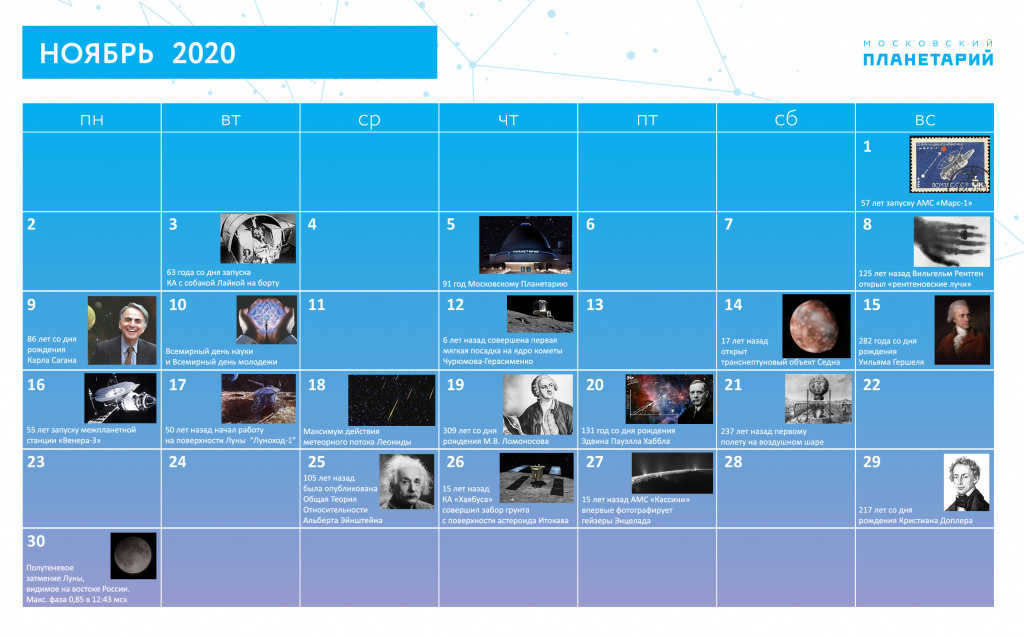
November 2020
People born in this month:
Astronomy highlights of November 2020:
November 1 – 57 years ago, on 01.11.1963, the Arecibo Observatory was inaugurated.
November 5 – 91 years since the opening of Moscow Planetarium! On November 5, 1929, the 13th largest planetarium in the world and the first in the USSR was established in Moscow.
November 8 – 125 years ago, on November 8, 1895, physicist Wilhelm Roentgen made the groundbreaking discovery of “X-rays”.
November 10 – Celebrated as World Science Day and World Youth Day.
November 11 – 448 years ago (11.11.1572), Tycho Brahe discovered the supernova eruption in Cassiopeia (SN1572).
November 12 – 5 years ago, on 12.11.2015, the foundation stone for the construction of the European Extremely Large Telescope (European Extremely Large Telescope) was laid in the Atacama Desert, Chile, with a mirror diameter of 39.3 meters.
November 14 – 17 years ago, on November 14, 2003, the trans-Neptunian object Sedna was first identified. Sedna takes approximately 11,400 years to complete a full orbit in its highly elongated trajectory, which ranges from 76 astronomical units at its closest point to the Sun to 900 astronomical units at its farthest point.
November 17. – 54 years ago, on November 17, 1966, Earth witnessed the most intense meteor shower, the Leonids, with up to 10,000 meteors per hour illuminating the sky.
November 21 – 237 years ago (21.11.1783), the first ever human balloon flight took place. On this day, two brave Frenchmen, Pilatre de Rozier and Marquis d’Arland, embarked on the historic journey aboard the balloon created by the Mongolfier brothers. The balloonists reached a height of 915 meters and covered a distance of 9 km in just 25 minutes.
November 25 – 105 years ago (25.11.1915), Albert Einstein’s General Theory of Relativity was published.
Key dates and events in astronautics during November 2020:
November 1 – Fifty-eight years ago, on November 1, 1962, the Soviet Union successfully launched the groundbreaking “Mars-1” automatic interplanetary station to explore the planet Mars using advanced space technology. The closest approach of the Mars-1 to Mars occurred on June 19, 1963.
November 3 – Sixty-three years ago, on November 3, 1957, the USSR launched the Sputnik-2 spacecraft with the historic passenger Laika, the first warm-blooded dog to venture beyond Earth’s atmosphere, marking the beginning of crewed space travel.
November 5 – Seven years ago (November 5, 2013), India achieved a significant milestone with the successful launch of its first interplanetary station, the Mars Orbiter Mission (MOM).
Nov. 9 – Fifty-three years ago, on November 9, 1967, the United States launched its first Saturn-5 LV, a monumental achievement in space exploration.
November 12 – Six years ago (November 12, 2014), the historic soft landing on a comet nucleus was accomplished by the descent module “Philae” of the Rosetta spacecraft, marking a major milestone in scientific exploration.
Nov. 15 – Thirty-two years ago, on November 15, 1988, the Soviet Union launched the impressive orbital rocket ship BURAN, a remarkable reusable transport space system developed under the Energia-Buran program.
November 16 – Fifty-five years ago (November 16, 1965), the groundbreaking “Venera-3” interplanetary station was successfully launched, becoming the first Earth vehicle to reach the surface of another planet – Venus.
November 17 – Fifty years ago (November 10, 1970), the pioneering automatic laboratory “Lunokhod-1” began its mission on the surface of the Moon. This remarkable achievement marked the first successful operation of a planetary rover on another celestial body, with Lunokhod-1 exploring the lunar surface from November 17, 1970, to September 14, 1971.
November 20 – Twenty-two years ago (November 20, 1998), the first module of the International Space Station (ISS), the Russian functional cargo block “Zarya,” was launched into orbit.
November 26 – Fifteen years ago (November 26, 2005), the Hayabusa spacecraft of the Japan Aerospace Exploration Agency collected soil samples from the surface of the Itokawa asteroid and successfully returned them to Earth, marking the first-ever delivery of asteroid soil samples.
November 27 – Forty-nine years ago (November 27, 1971), the AMS Mars-2 became the first spacecraft to successfully land on the surface of Mars.
November 27 – Fifteen years ago, on November 27, 2005, the AMS Cassini captured the first photographs of the famous geysers on Saturn’s moon Enceladus.
November 2020 Astronomical Celestial Calendar
Below you will find the astronomical events for November 2020, all times are given in Moscow Time (Tmsk = UT + 3h, where UT is World Time). The Moon will be in different phases throughout the month, which will be represented by the symbol F (0.0+-): F = 0.00 (new moon), F = 0.50+ (first quarter), 1.00 (full moon), F = 0.50- (last quarter). The stellar magnitude for the luminaries will be indicated with a deviation of +-0.0m.
On November 1, the Moon (F= 1.0) will pass to the south of Uranus.
On November 2, the Moon (F= 0.96-) will pass to the south of the Pleiades.
On November 2, Mercury will be at perihelion.
On November 3, the Moon (F= 0.94-) will pass 2.6° to the north of the Hyades and Aldebaran (09:00).
On November 3, Mercury will be in station with a transition from sideways to direct motion (12:00).
On November 4, Mercury’s morning visibility will begin.
On November 6, the Leonids meteor shower will begin.
On November 6, the Moon (F= 0.59-) will pass 4° to the south of Pollux (+1.2m) (22:00).
On November 7, the Moon (F= 0.58-) will pass to the north of the star cluster Nursery (M44).
On November 8, the Moon will be in the last quarter phase (16:48).
On November 9, the Moon (F= 0.4-) will pass to the north of Regulus (17:00).
On November 10, Mercury will be at its greatest elongation: 19.1° (morning).
On November 12, the Moon (F= 0.08-) will pass 3° to the north of Venus (- 4.0m) (03:00).
On November 13, the Moon (F= 0.07-) will pass 6° to the north of Spica (+1.0m) (10:00).
On November 14, the Moon (F= 0.03-) will pass 2° to the north of Mercury (- 0.7m) (01:00).
On November 14, the Moon (F= 0.01-) will be at the perigee of its orbit at a distance of 357838 km (14:49).
On November 15, there will be a New Moon (08:09).
On November 15, Mars will be in a standing orbit with a transition from sideways to direct motion (22:00).
On November 16, Venus (- 4.0m) will pass 4° to the north of Spica (+1.0m) (22:00).
On November 16, the Moon (F = 0.02+) will pass to the north of Antares.
On November 17, there will be the maximum of the Leonids meteor shower (14:00). Conditions for observing Leonids in 2020 are favorable. It is expected up to 15-20 meteors per hour at the zenith. The waxing Moon (F=0.05) will not interfere with observations.
On November 19, the Moon (F=0.23+) will be near Jupiter and Saturn – passing 2° to the south of Jupiter (- 2.1m) and 3° to the south of Saturn (+0.6m).
On November 22, the Moon will be in the first quarter phase (07:46).
On November 23, the Moon (F = 0.63+) will pass to the south of Neptune (+7.9m) (19:00).
On November 24, the morning visibility of Mercury will end.
On November 26, the Moon (F= 0.82+) will pass 4° to the south of Mars (- 1.3m) (03:00).
On November 27, the Moon (F= 0.90+) will be at the apogee of its orbit at a distance of 405890 (00:30).
On November 27, the Moon (F= 0.93+) will pass 3° to the south of Uranus (+5.7m) (22:00).
On November 29, Neptune will be in waxing and waning (15:00).
On November 30, the Moon (F= 1.0) will pass to the north of the Hyades and Aldebaran.
On November 30, there will be a Full Moon (12:32).
On November 30, there will be a penumbral eclipse of the Moon visible in eastern Russia (13:00) with a max phase of 0.85 at 12:43 MSK. This eclipse will not be observable in Moscow. It will be visible in the eastern half of our country. Its maximum penumbral phase will be 0.85 when the Moon passes through the southern part of the Earth’s penumbra. At this phase, the Moon will not be far from the Earth’s shadow, so you can try to see the eclipse even with the naked eye.
November’s Sparkling Skies
The breathtaking night sky in November is truly a sight to behold. On a crisp and chilly evening, one can marvel at the brilliance of the winter constellations, as they twinkle above the horizon.
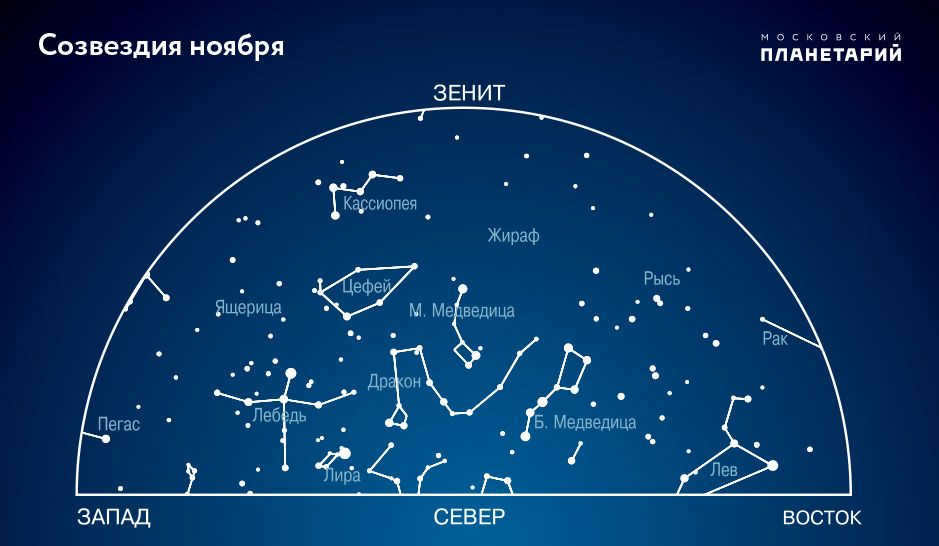
During the month of November, in the late hours after midnight, the constellation Leo can be seen rising in the eastern part of the sky, emerging from the horizon. Leo is easily identifiable due to the presence of the bright star known as Regulus. Meanwhile, in the northeastern region of the sky, situated high above the horizon, one can observe the famous constellation of the Big Dipper. Moving towards the northwest, near the horizon, the constellations Lyra and Swan can also be seen, with their prominent stars Vega and Deneb shining brightly.
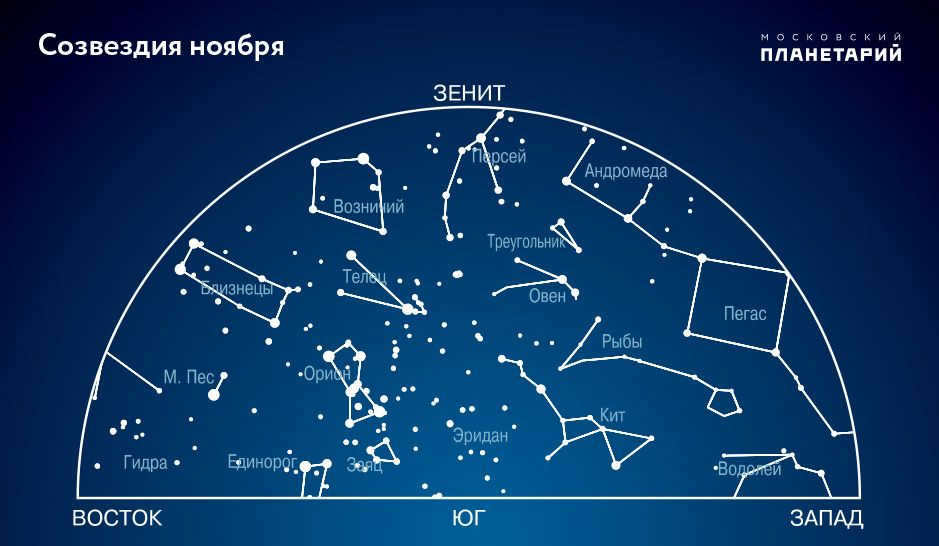
In the southern part of the celestial sphere, close to the zenith, one can marvel at the constellation Perseus and its neighboring constellation Charioteer. A little lower, towards the left, lies Taurus, and further down, towards the east, is the prominent constellation Orion, adorned with its brilliant stars Betelgeuse, Rigel, and Bellatrix. To the southwest, one can observe Pegasus and Andromeda high up in the sky, and just below them, near the horizon, is the majestic constellation the Whale. To the southeast, high up in the celestial dome, Gemini reigns, with the Little Dog shining below them, accompanied by the radiant star Procyon. Finally, near the horizon, the brightest star in the entire night sky, Sirius (alpha of the Big Dog), illuminates the darkness.
* The Leonids Meteor Shower in November
The entire month of November, specifically from November 6 to November 30, is the time when the Leonids meteor shower is visible. This meteor shower is named after the constellation of Leo (Leon), as its radiant is located there. The peak of activity for the Leonids meteor shower is expected to occur on November 17, 2020 (at 14:00 Moscow time).
Favorable conditions are expected for observing the Leonids in 2020. The peak of the Leonids meteor shower can be seen during the night of November 16-17, 2020, between midnight and dawn. The Moon, which recently passed the new moon phase on November 15th, will be below the horizon throughout the night, allowing for uninterrupted observation of the Leonid meteors. It is anticipated that there will be 15-20 meteors per hour during the peak in 2020. The Leonid meteors are known for their brightness and speed, reaching up to 71 km/s. For a successful observation of these “shooting stars,” it is highly recommended to have a clear sky with minimal or no moonlight interference.
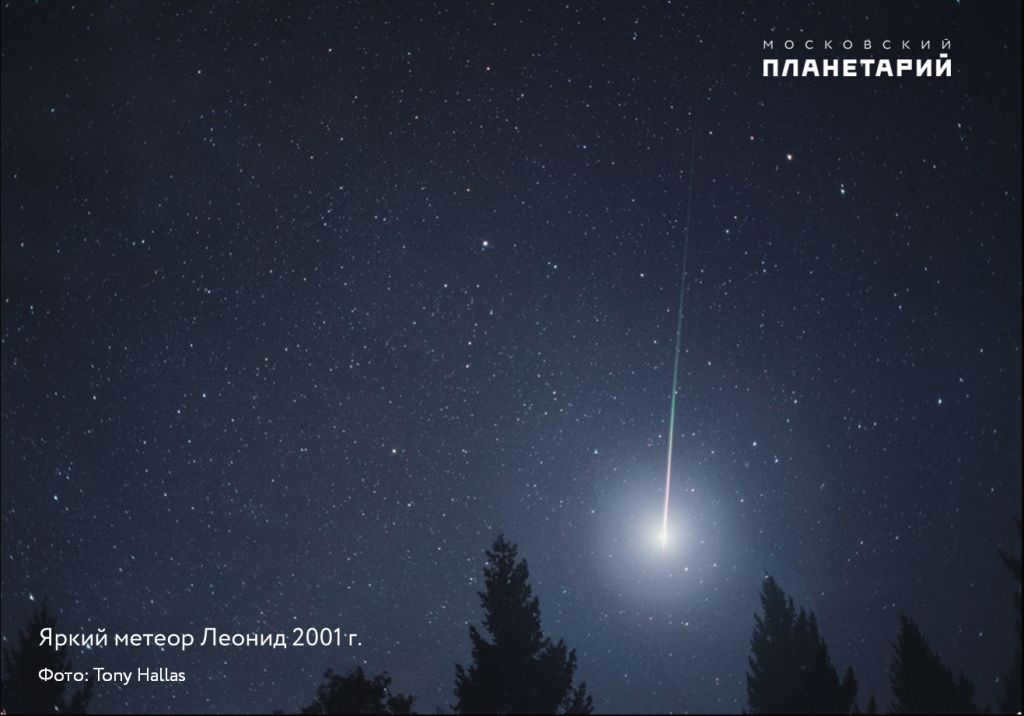
Sol
The Sun will transition from the constellation Libra to Scorpio on November 23, and then enter Serpens on November 29. By the end of November, the Sun’s declination will reach 21.5 degrees south of the celestial equator, resulting in a shorter duration of daylight in the northern hemisphere. In the beginning of the month, the day length is 9 hours 12 minutes, but by the end of the period it decreases to 7.5 hours, just half an hour more than the minimum day length. These measurements are specific to the latitude of Moscow, where the Sun’s altitude at noon will decrease from 19 to 12 degrees over the course of the month. Observing the Sun can be done on any clear day, but it is important to remember that visual observations using telescopes or other optical devices must always be done with a solar filter (recommendations for observing the Sun are available in the “Nebosvod” journal).
The November 30, 2020 Penumbral Eclipse of the Moon
Solar and lunar eclipses happen approximately every six months, with a two-week gap between them. These extraordinary celestial events occur when the Sun, Earth, and Moon align in a straight line. If the Moon is positioned in the middle, a solar eclipse is observed, whereas a lunar eclipse is witnessed when the Earth is in the middle.
Lunar eclipses take place during the full moon when the Earth is positioned between the Sun and the Moon. If the Moon enters the Earth’s shadow cone and takes on a reddish tint, it is known as a total lunar eclipse. However, the Earth also has a “penumbra,” where the Moon partially sets for the fourth time in 2020 (!). These types of lunar eclipses are referred to as penumbral eclipses.
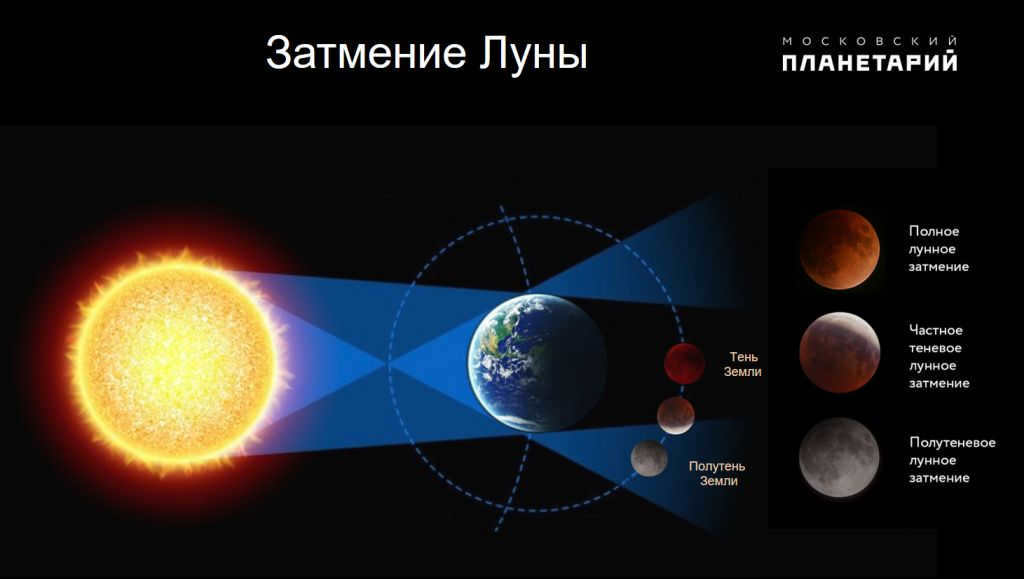
Russians witnessed the first lunar eclipse of 2020 in the evening of January 10, followed by the second on June 5 and the third on July 5.
Details of the penumbral eclipse visibility on November 30, 2020
On the 30th of November, the fourth penumbral eclipse of the year 2020 will take place. Most of the Moon will be within the Earth’s penumbra and will not appear reddish in color. Approximately 0.85 of the lunar disk will be immersed in the Earth’s penumbra. This phenomenon will only be visible to residents in the eastern regions of our country. They will have the opportunity to witness the maximum and partial phases of this eclipse. Observing this eclipse in Moscow will not be possible as the Moon will be below the horizon during the eclipse. The penumbral lunar eclipse on the 30th of November, 2020 will occur during daylight hours in most parts of Russia, making the full Moon invisible above the horizon. The greatest penumbral phase (0.85) is expected to occur at 12:43 Moscow time. At that time, the Moon will only be visible above the horizon in Northern and Eastern Siberia, where it will already be evening. The Moon will enter the penumbra with its northern edge, which is darker than its southern edge. Close to its maximum phase, the eclipse effect (darkening of the Moon’s northern edge) will be visible to the naked eye. However, the “blood moon” effect should not be anticipated as it only occurs during a total eclipse of the Moon when it is completely within the Earth’s shadow.
*For specific information on the start time and path of the lunar penumbral eclipse occurring on November 30, 2020 at a particular location, please refer to the interactive map provided by Xavier M. Jubier.
November 2020 Magnetic Storm Forecast
Moon and planets in November 2020
On November 1, the Moon (F= 1.0) will pass to the south of Uranus.
On November 12, the Moon (F= 0.08-) will pass 3° north of Venus (-4.0m) at 03:00.
On November 14, the Moon (F= 0.03-) will pass 2° north of Mercury (-0.7m) at 01:00.
On November 19, the Moon (F= 0.23+) will be in close proximity to Jupiter and Saturn.
On November 23, the Moon (F= 0.63+) will pass to the south of Neptune (+7.9m) at 19:00.
On November 26, the Moon (F= 0.82+) will pass 4° south of Mars (-1.3m) at 03:00.
On November 27, the Moon (F= 0.93+) will pass 3° south of Uranus (+5.7m) at 22:00.
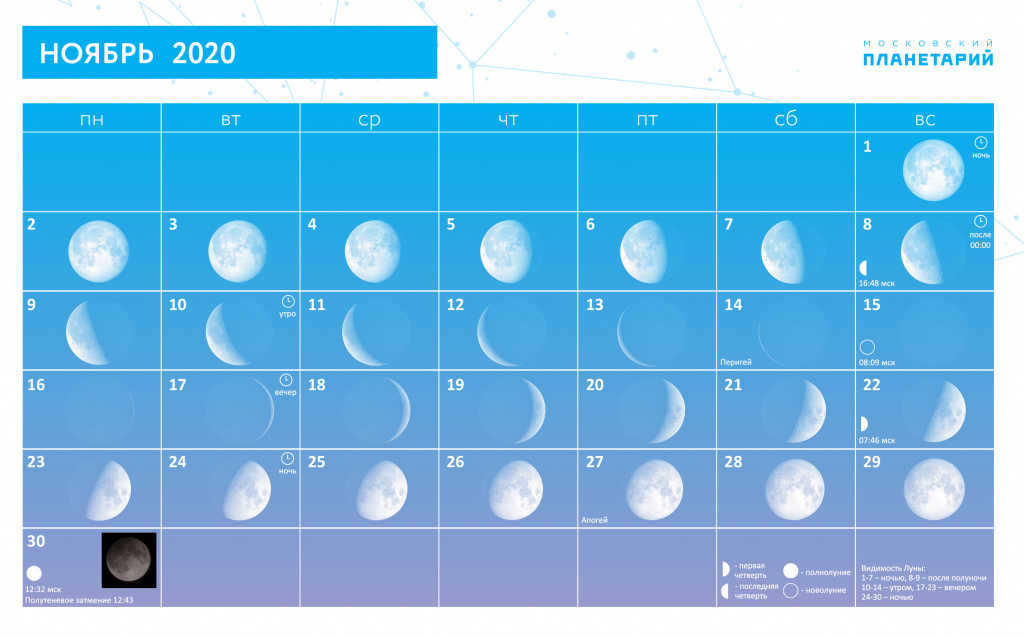
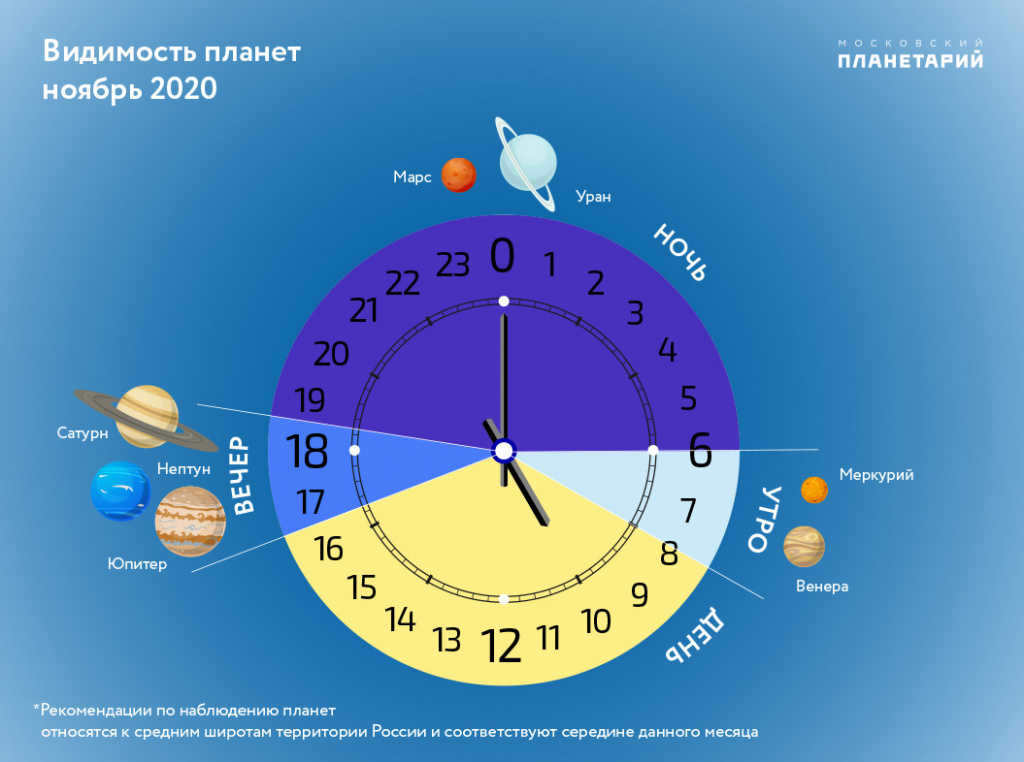
Mercury:
The elusive planet Mercury will be visible in the morning sky for most of November, rising high above the horizon. Its visible diameter will slowly reduce from 9 to 5 arc seconds throughout the month, while its luminosity will increase from 1m to -0.7m. As the month progresses, Mercury’s phase will gradually increase from 0.15 to 0.95. This means that when observed through a telescope, Mercury will appear as a small crescent shape, then a half disk, and finally an oval.
The planet will move in the same direction as the Sun throughout November, starting in the constellation Virgo on November 3 and transitioning to Libra on November 16. On November 10, Mercury will reach its maximum western elongation of 19 degrees, indicating its furthest distance from the Sun in the morning sky. After this point, the angular distance from the Sun will begin to decrease, reaching 11 degrees by the end of the month. This means that Mercury will gradually become hidden in the Sun’s rays.
In the image below (in Moscow time), you can see the constellations that Mercury and Venus will be visiting during the autumn of 2020:
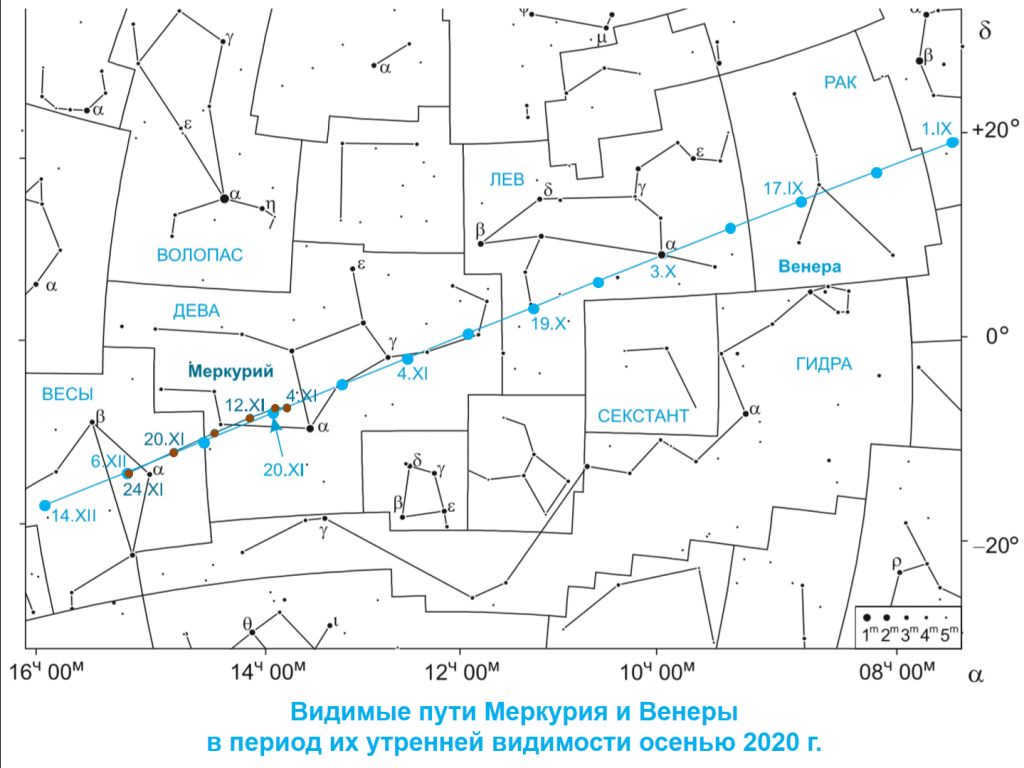
On November 2, Mercury will be at its closest point to the Sun (perihelion).
On November 3, Mercury will be in a stationary position, transitioning from sideways to direct motion at 12:00.
On November 4, Mercury’s morning visibility will begin.
On November 10, Mercury will reach its greatest elongation of 19.1° in the morning.
On November 24, Mercury’s morning visibility will end.
To successfully observe Mercury during these visibility periods, it is recommended to use binoculars, have an open horizon, and clear twilight skies.

